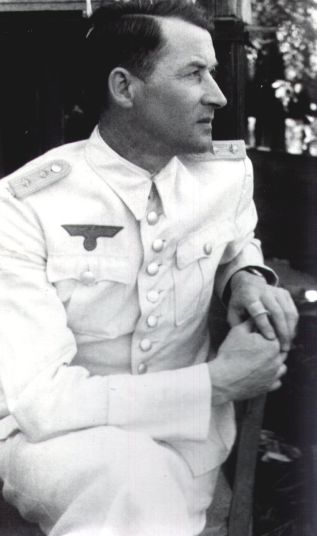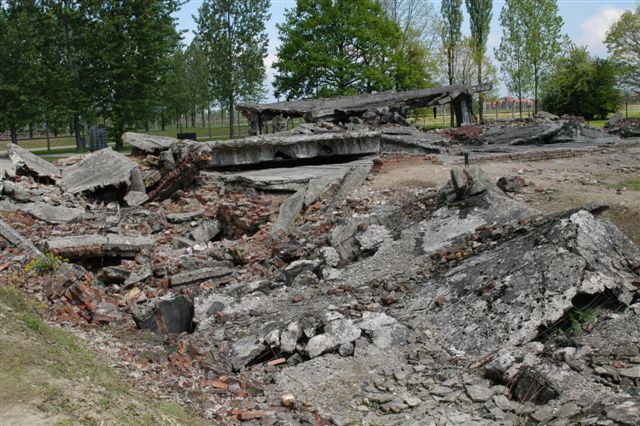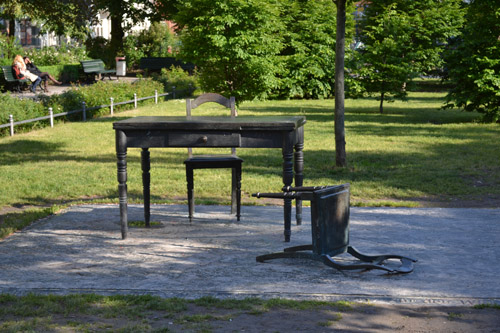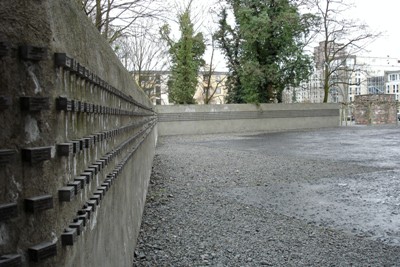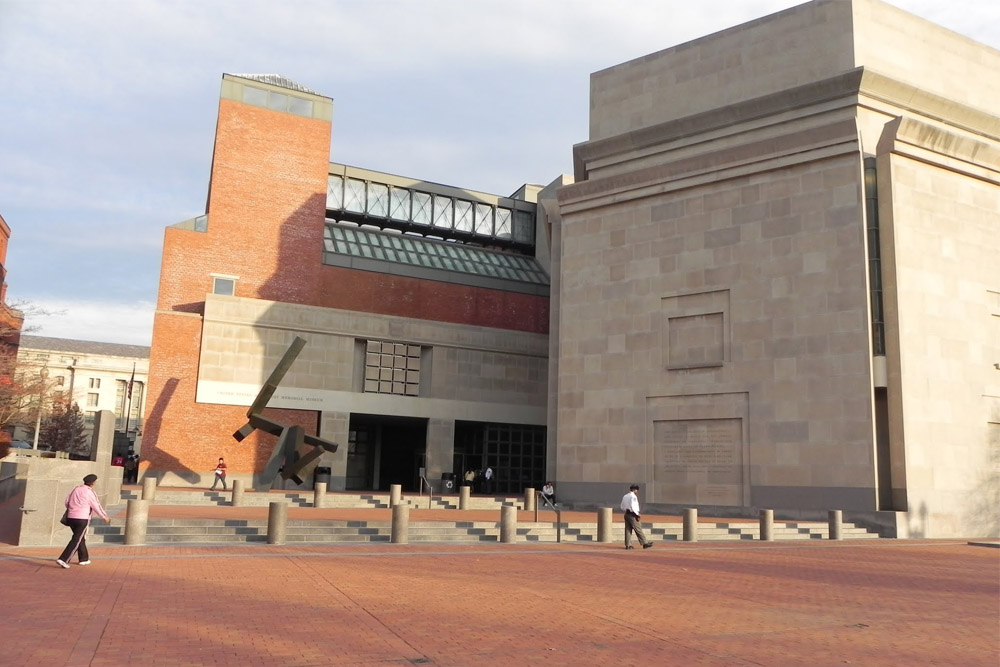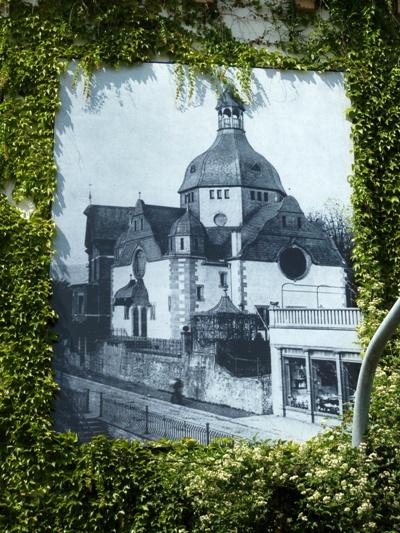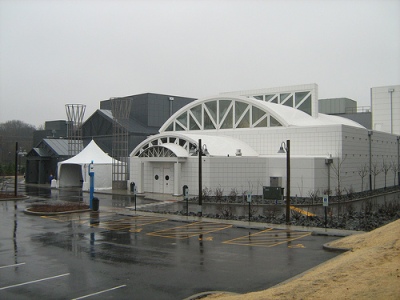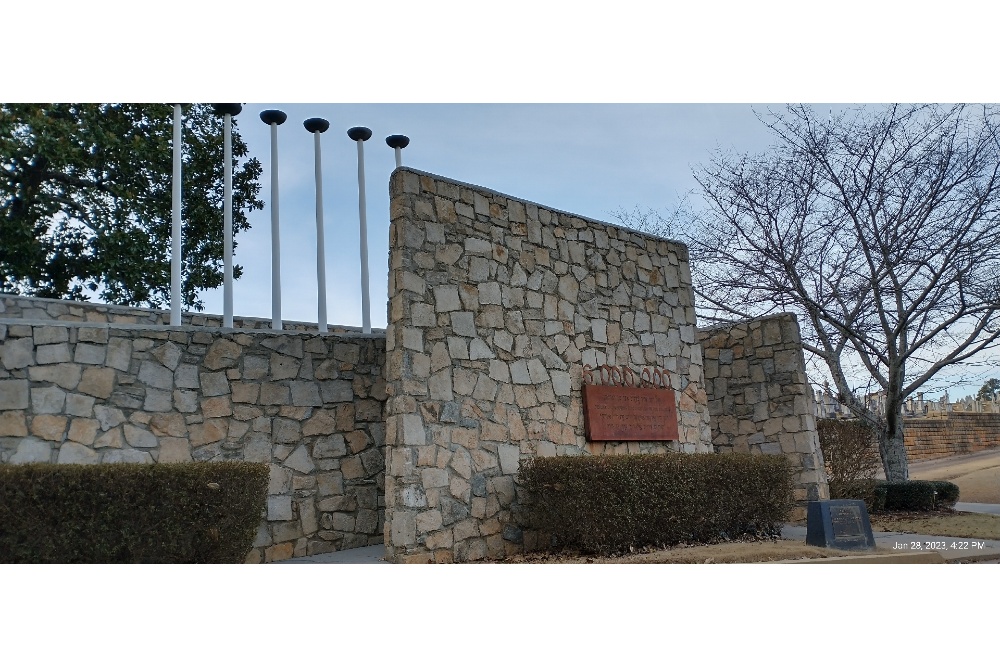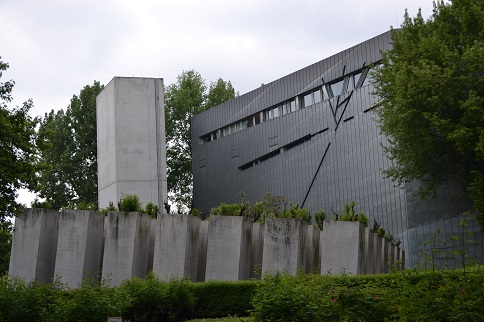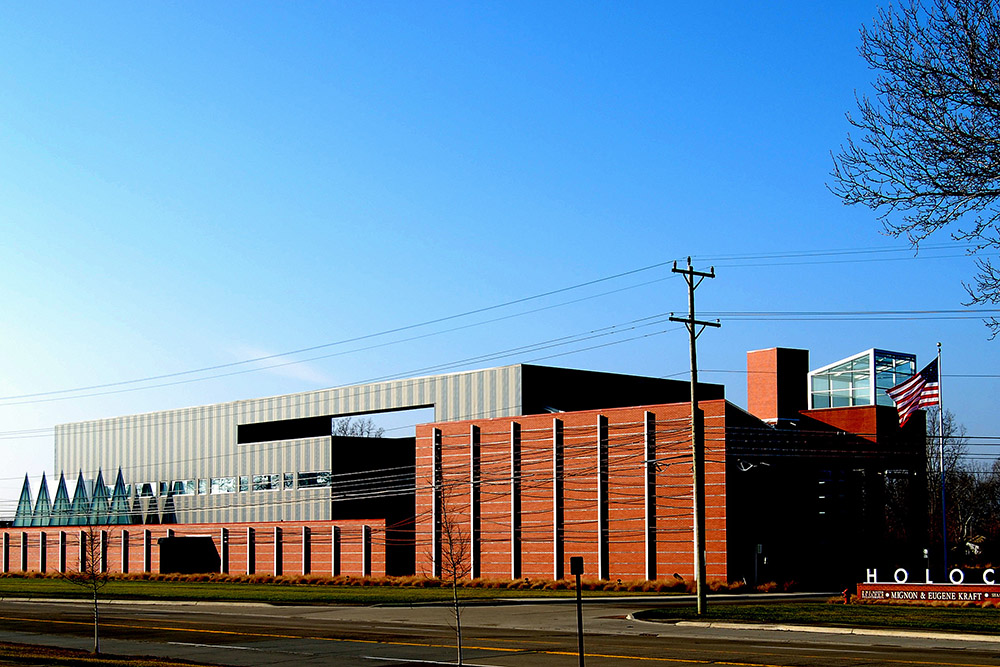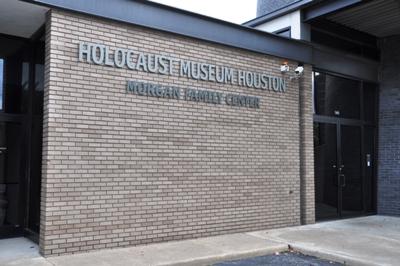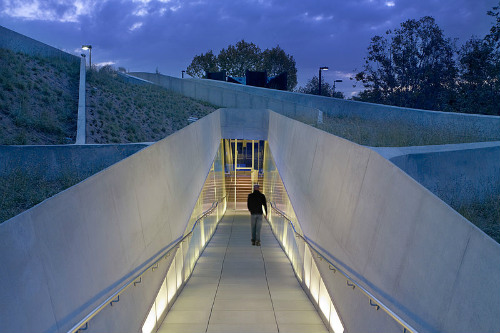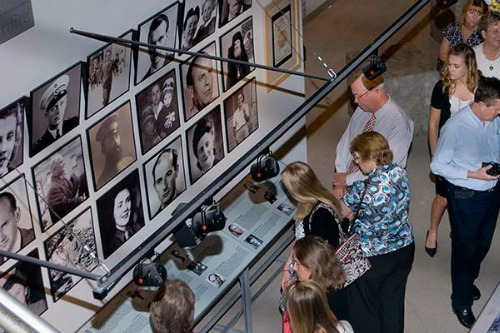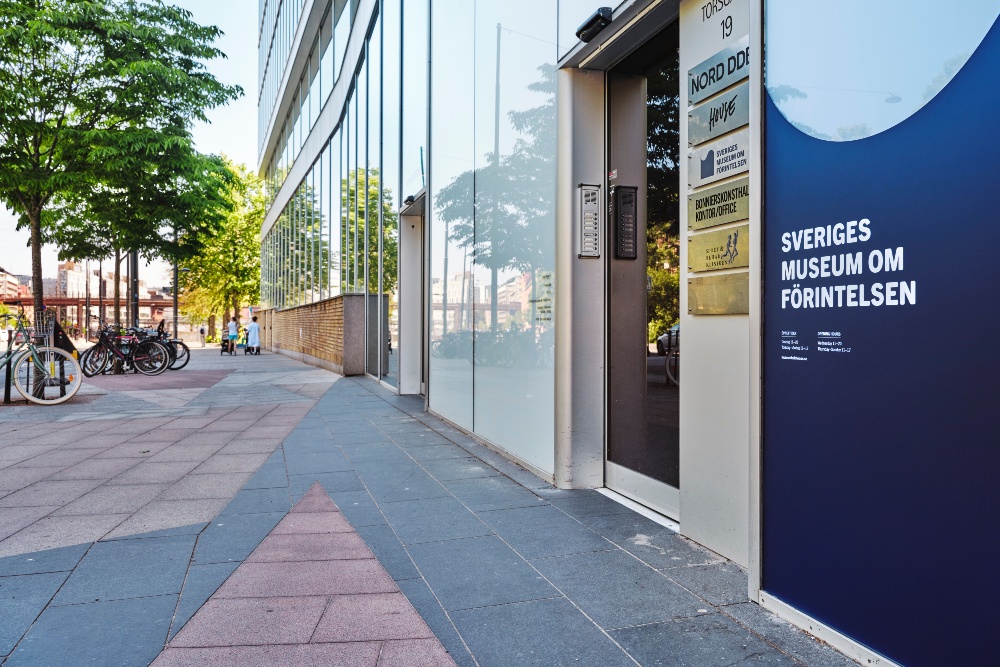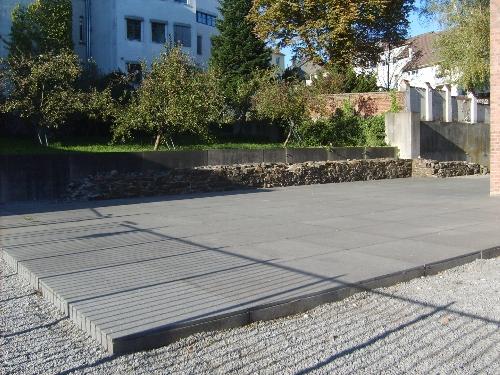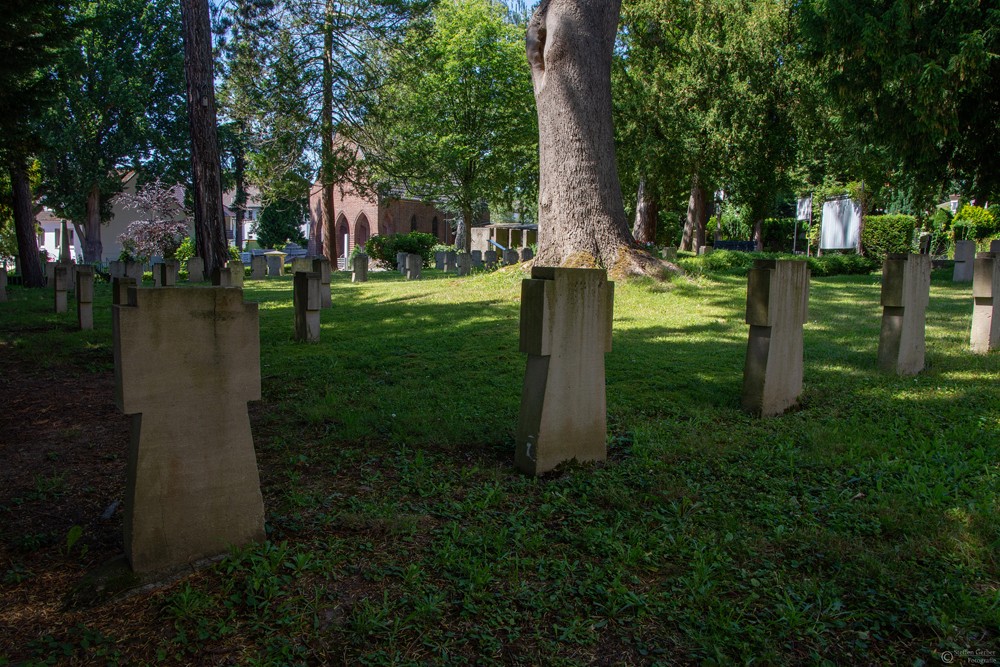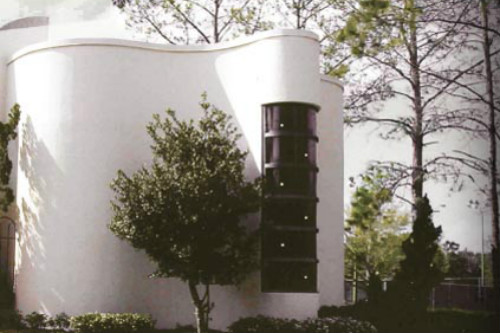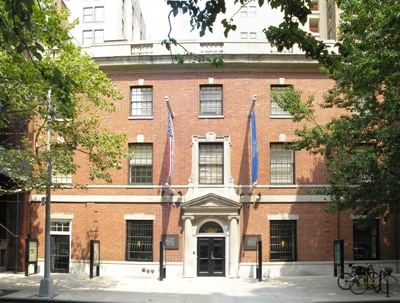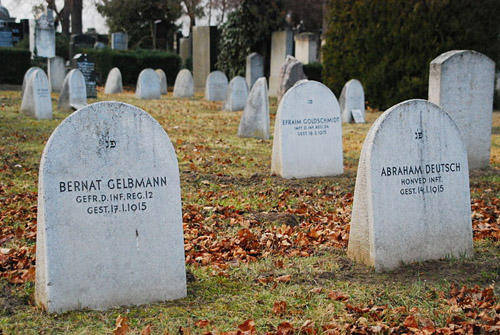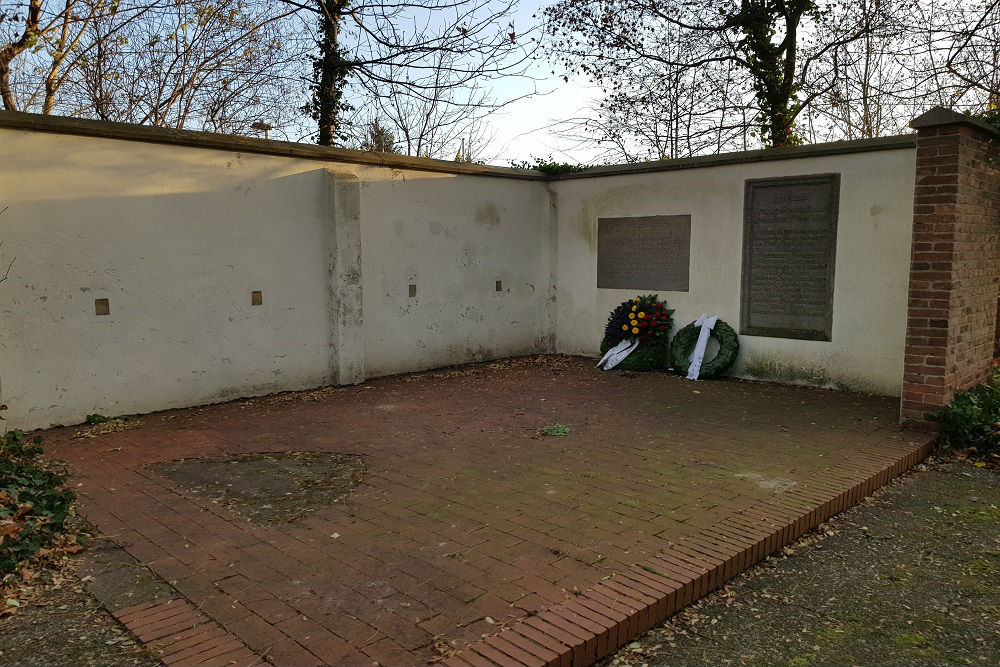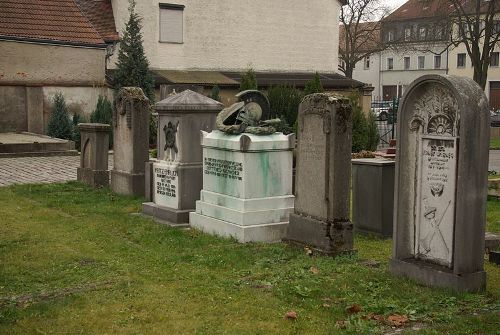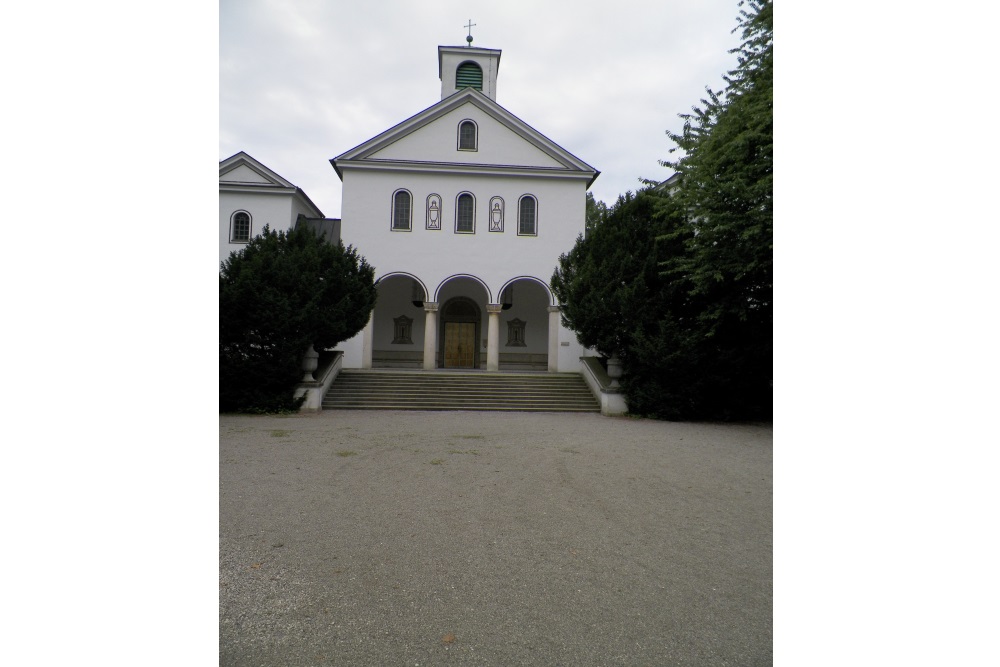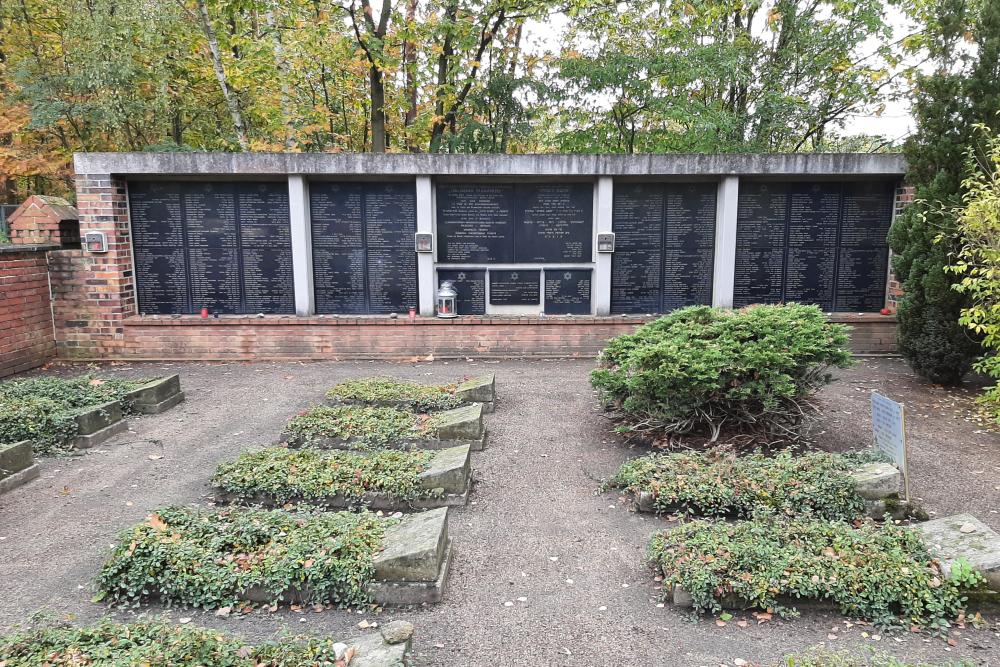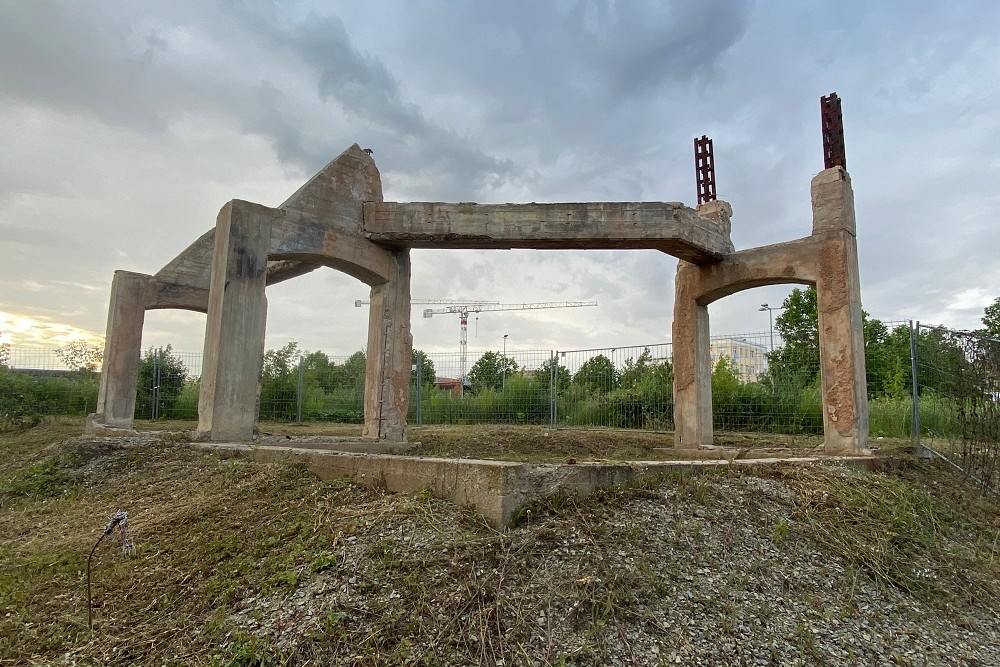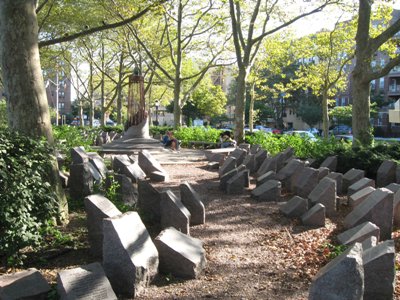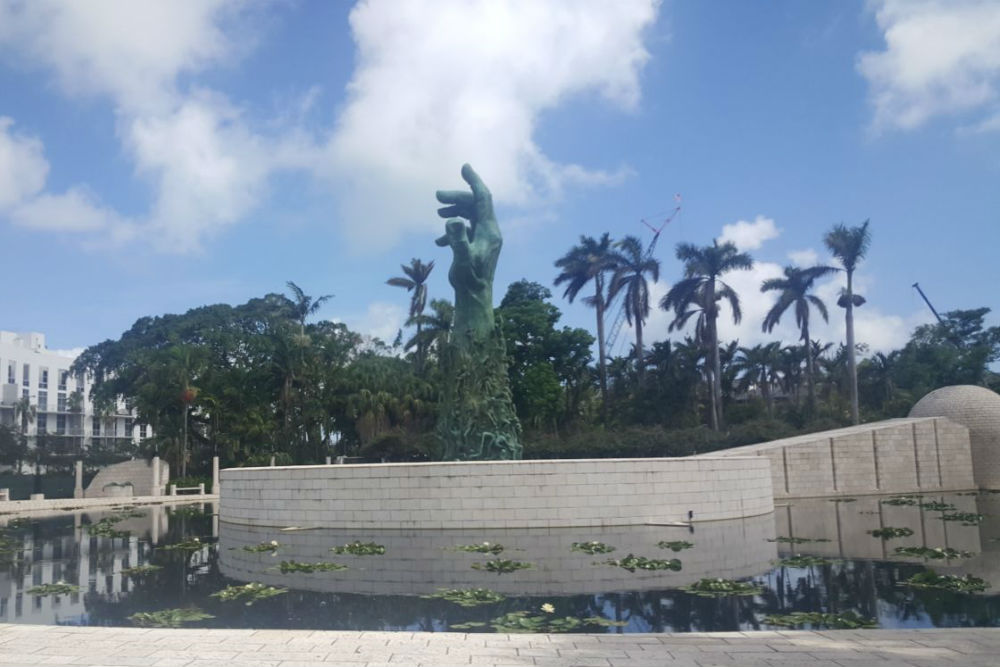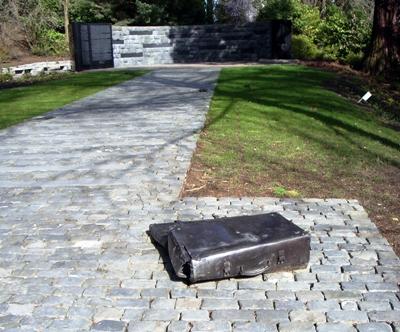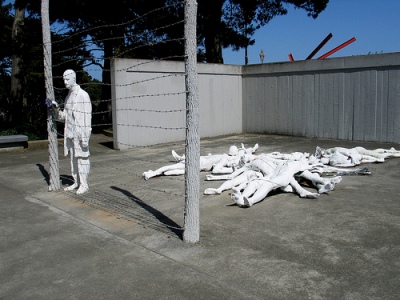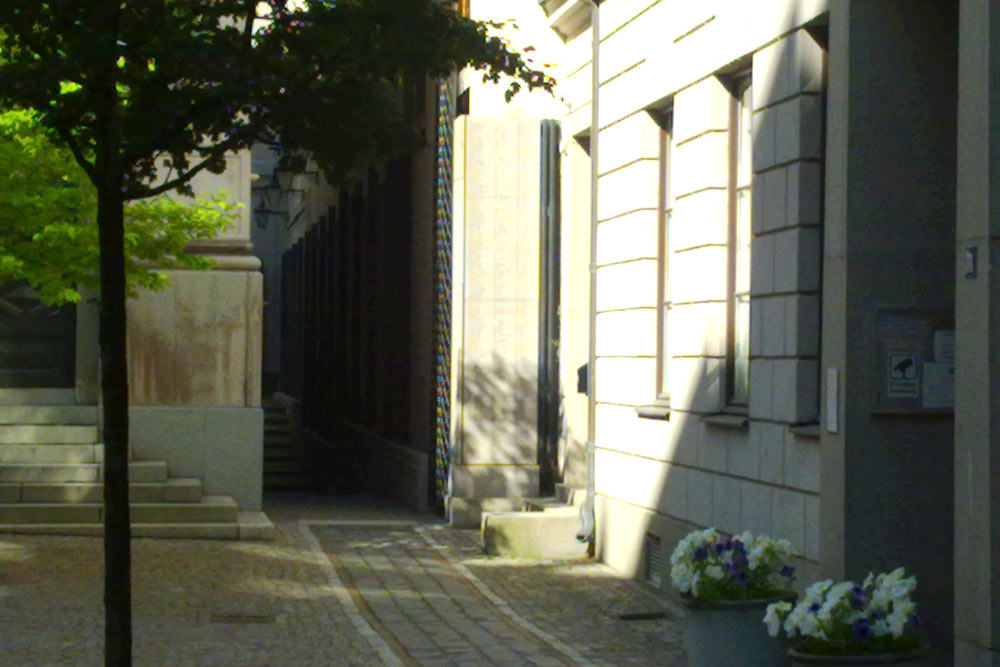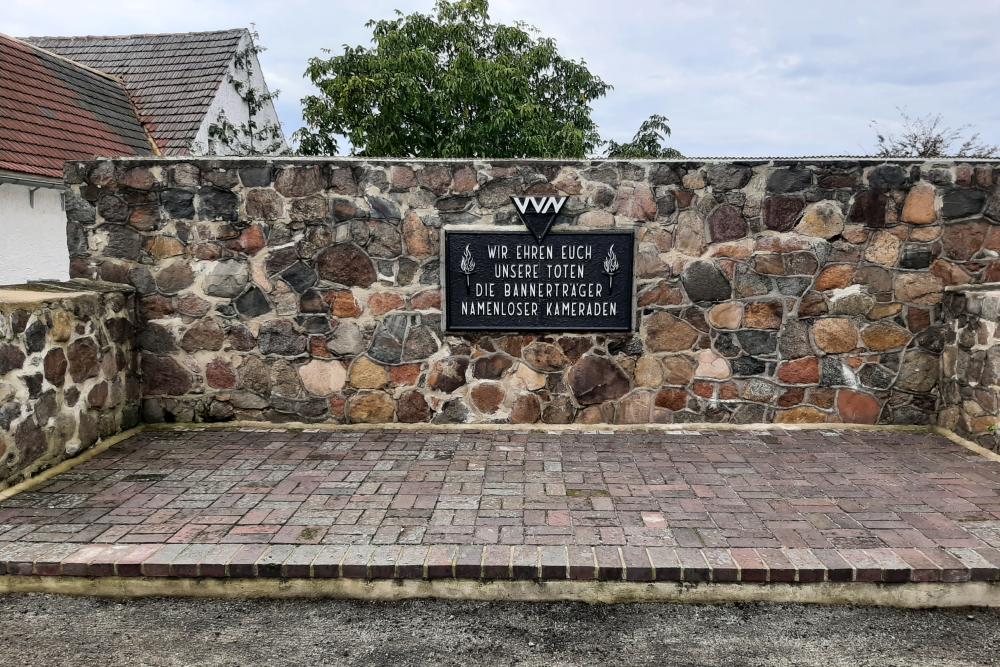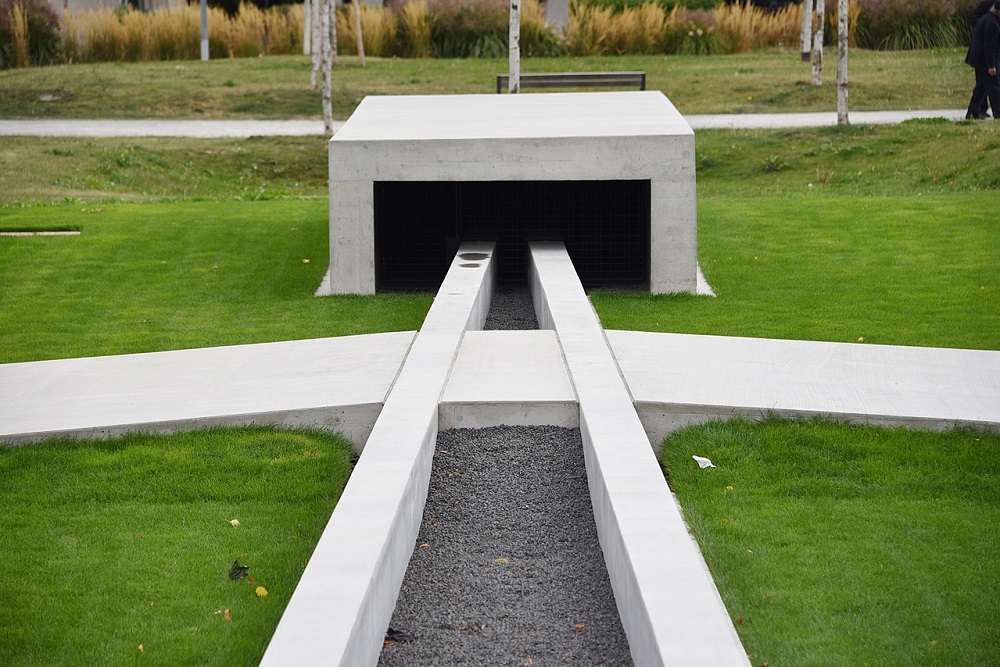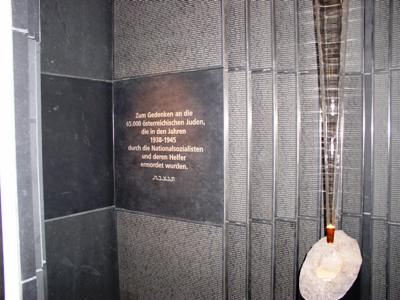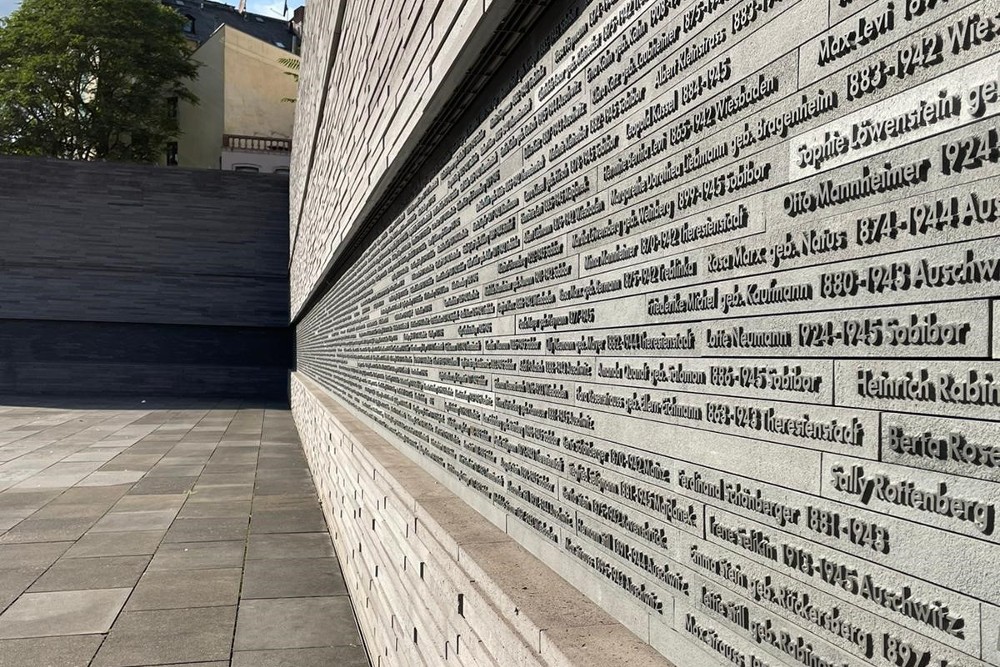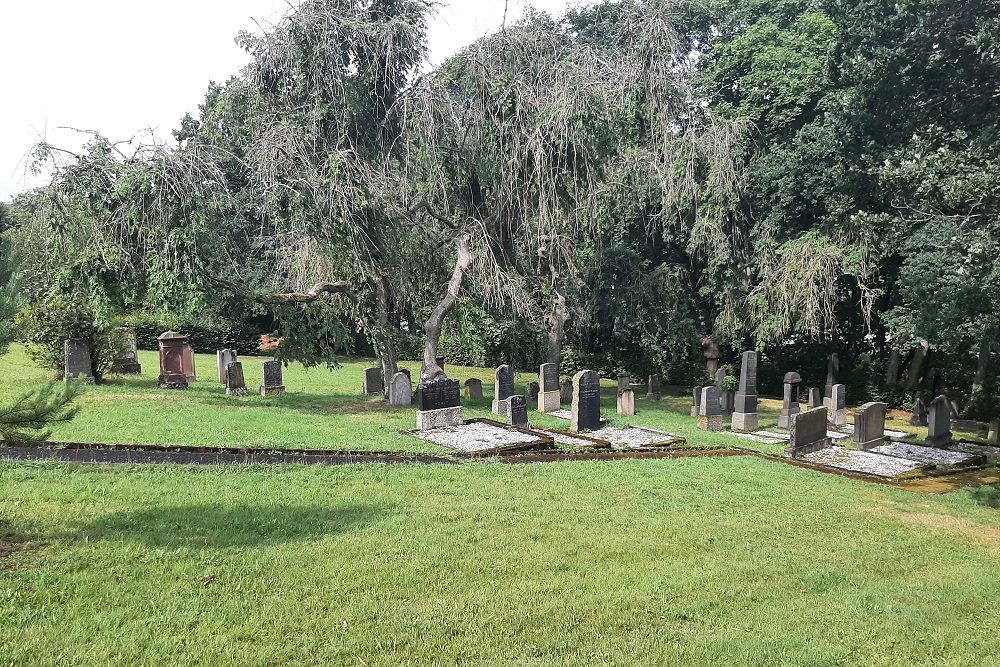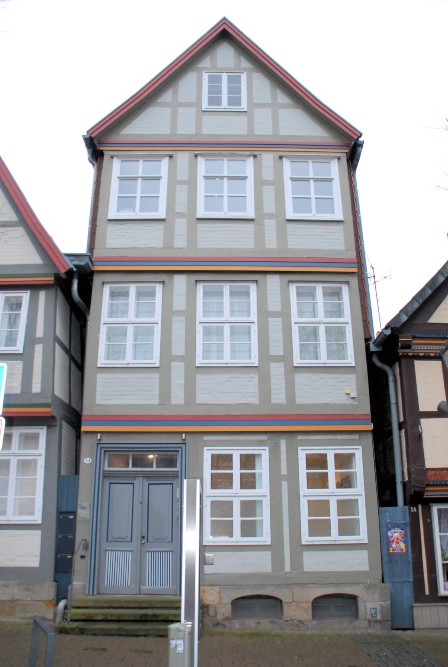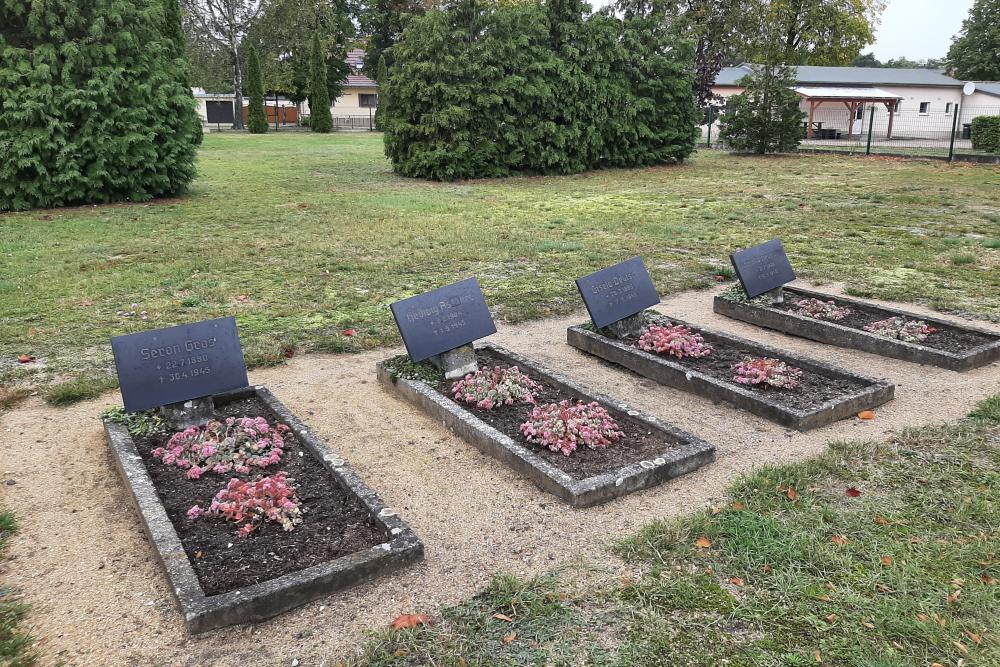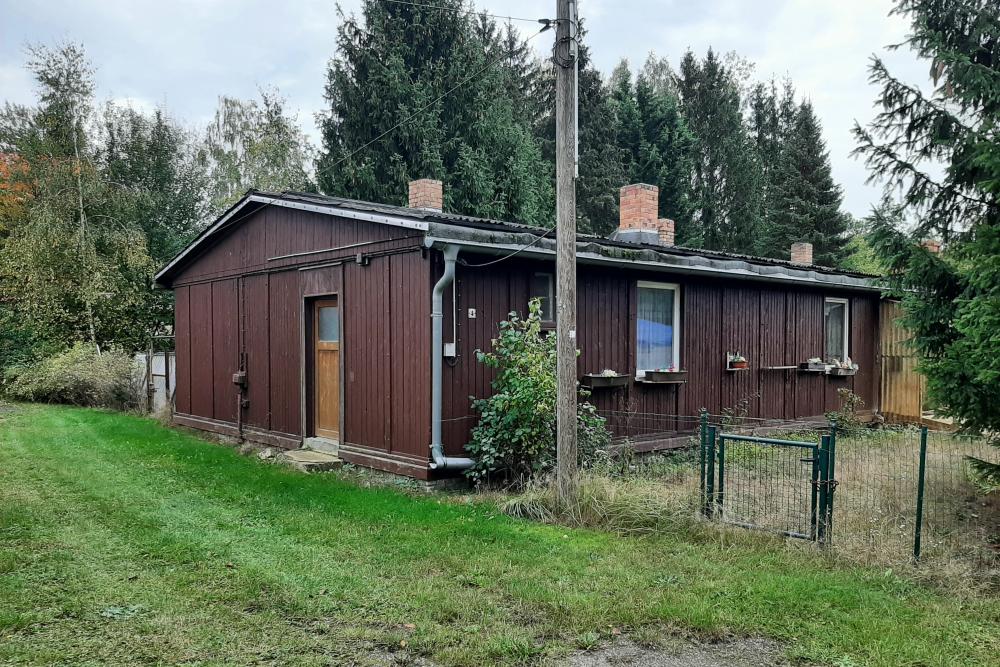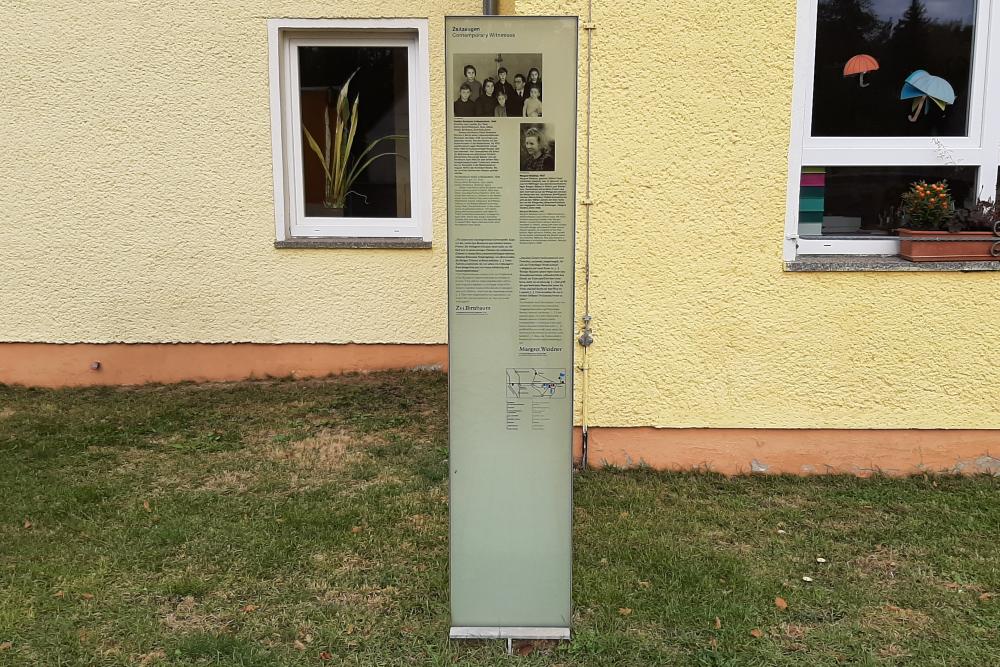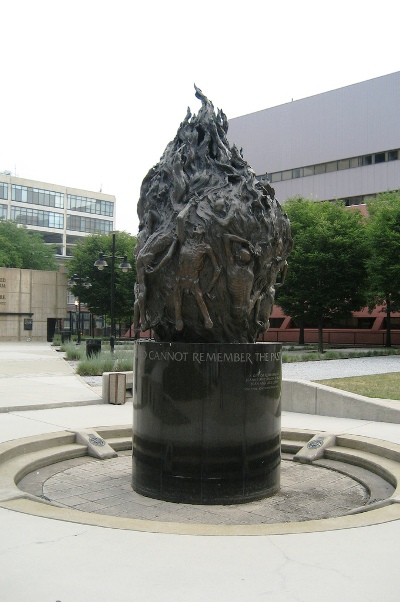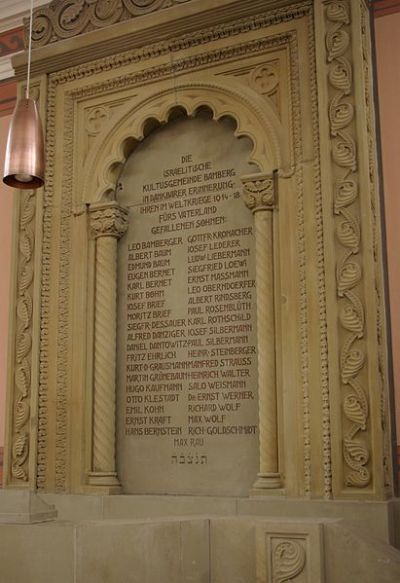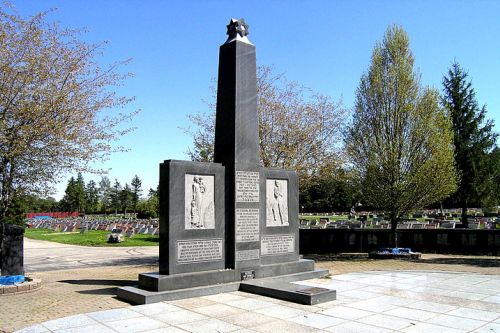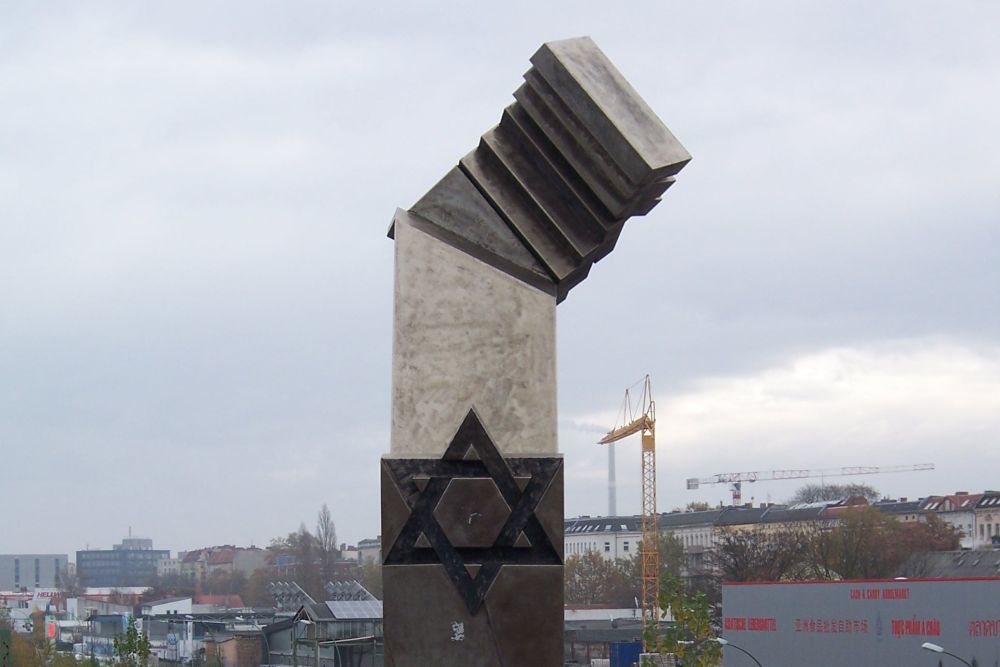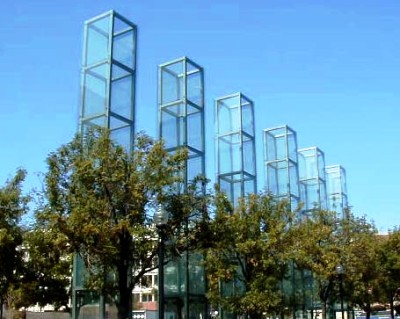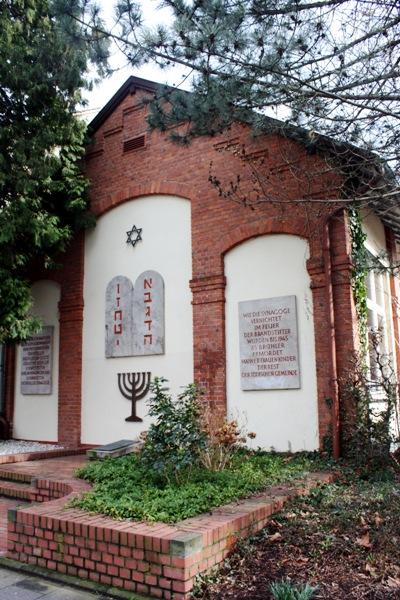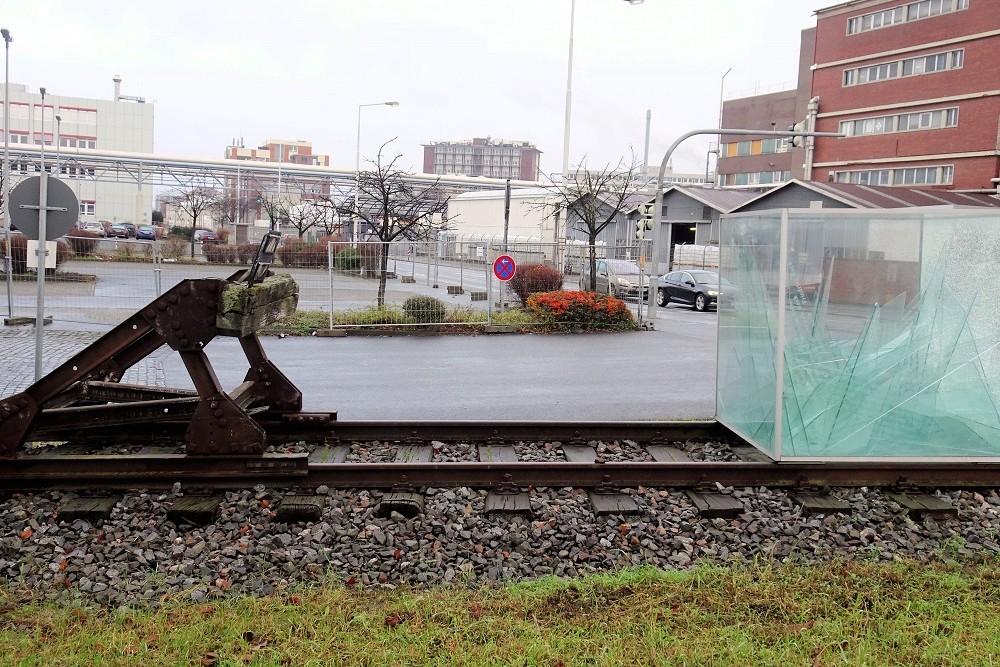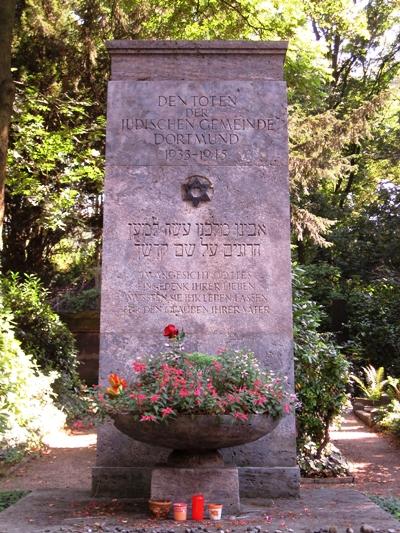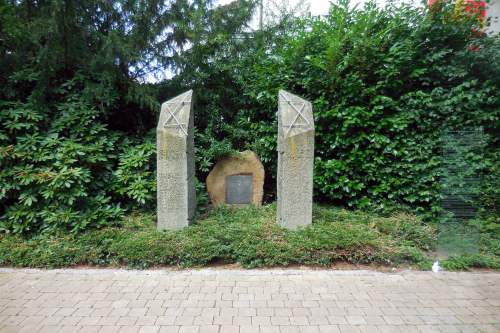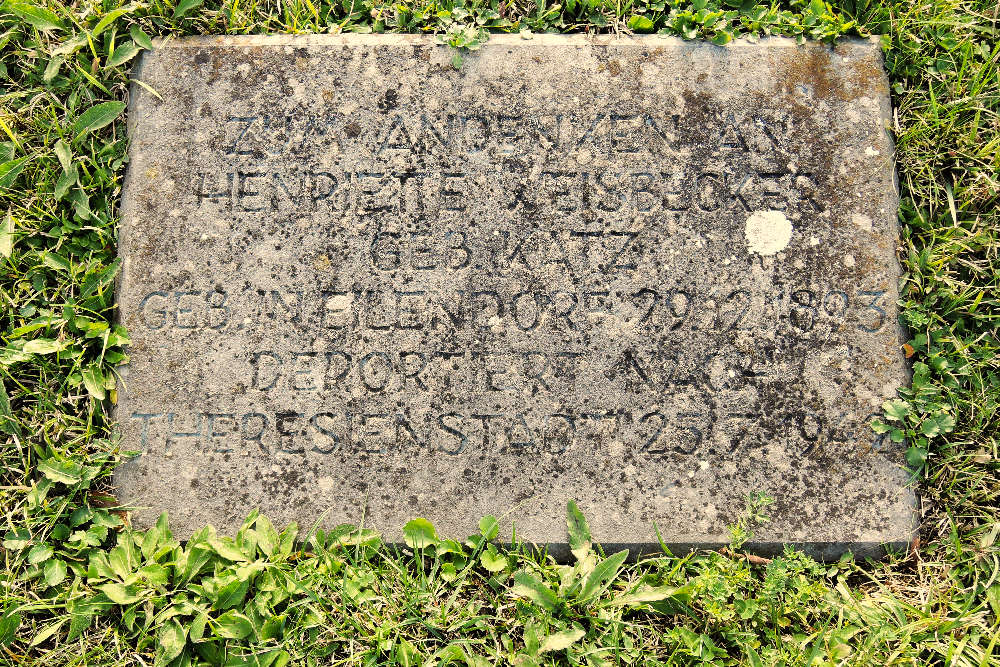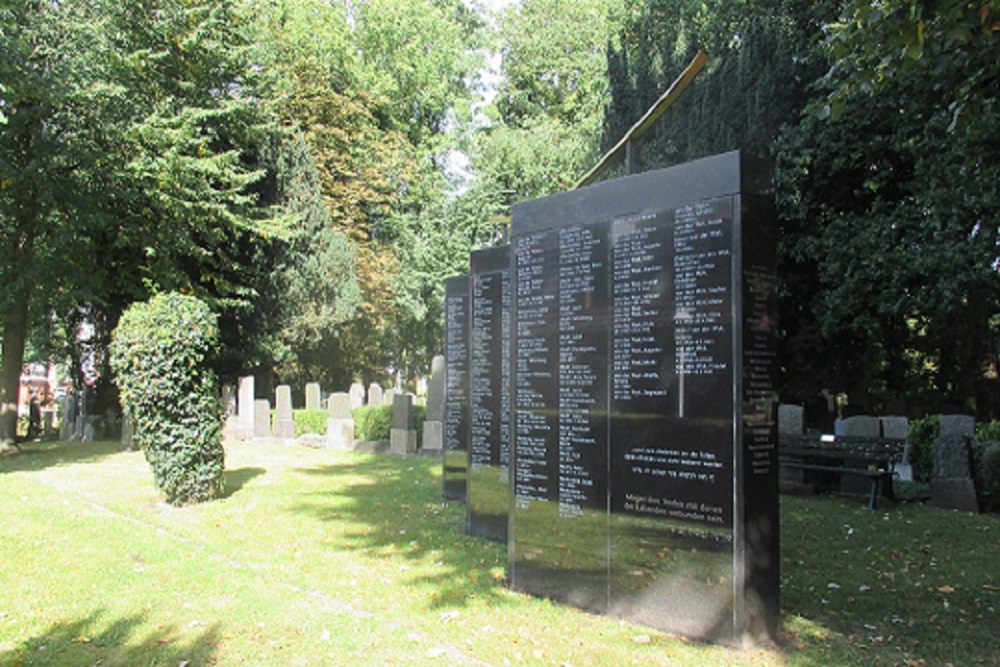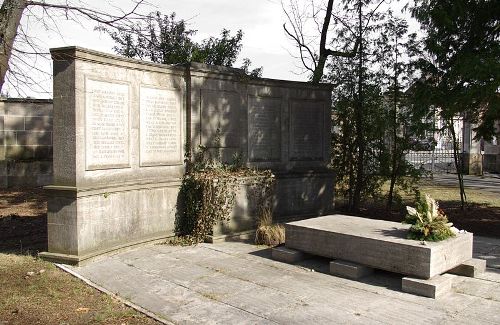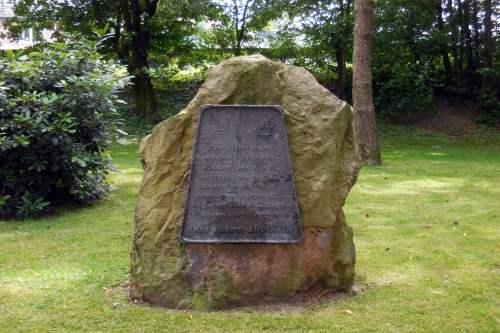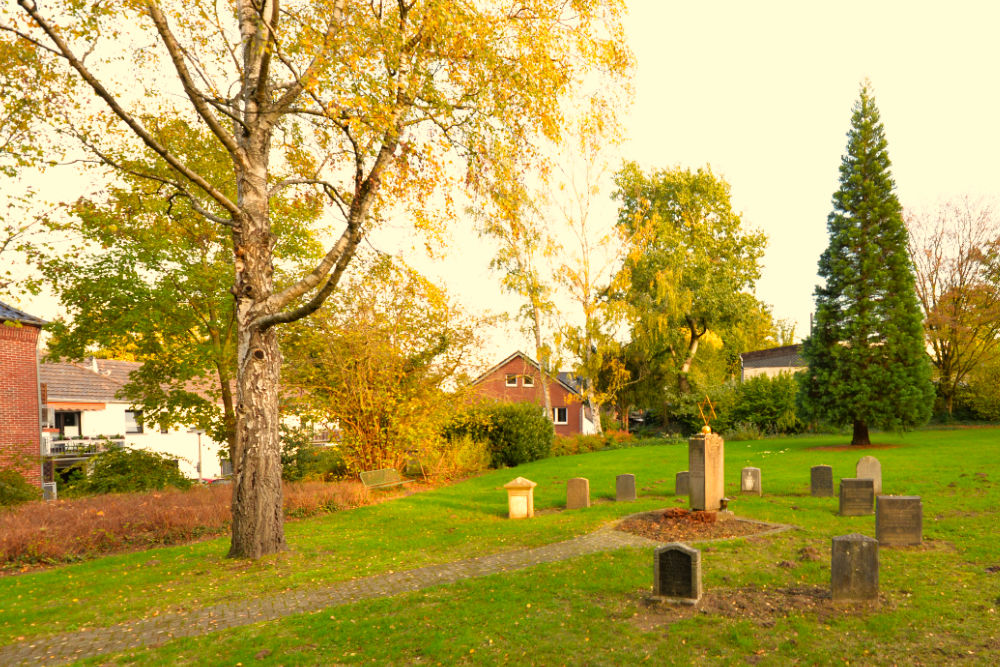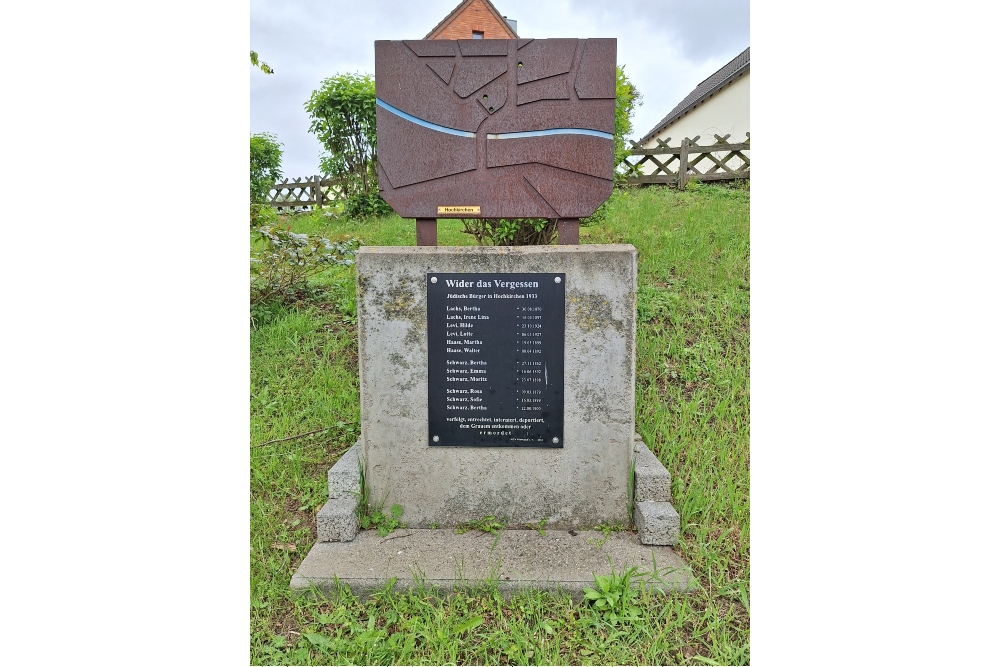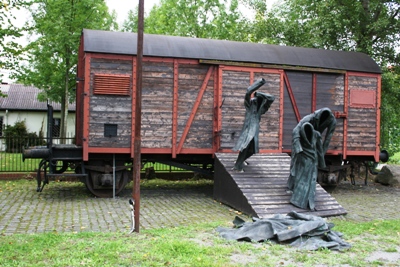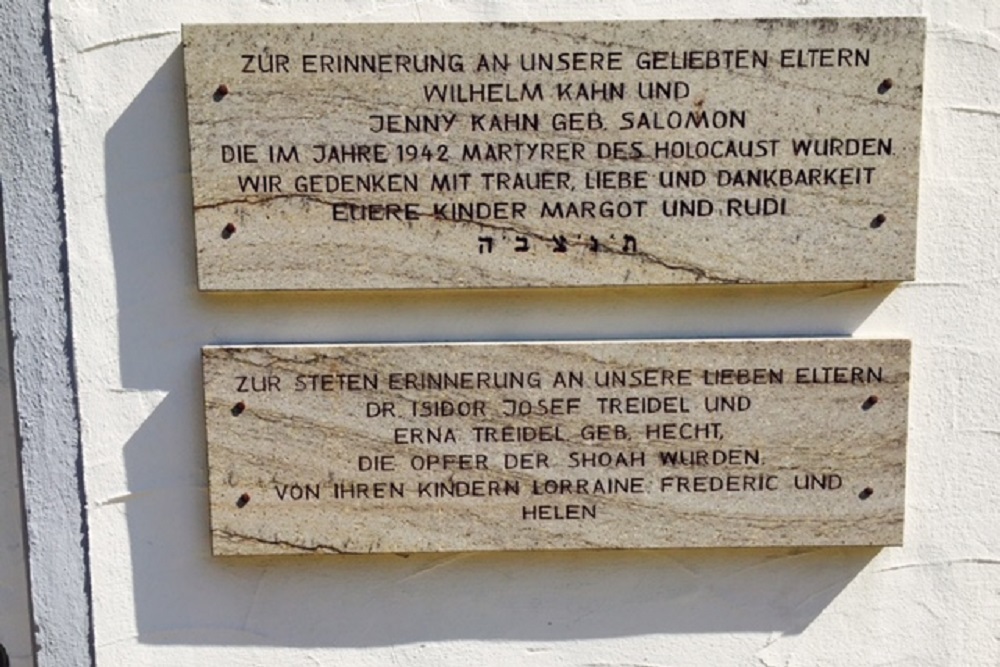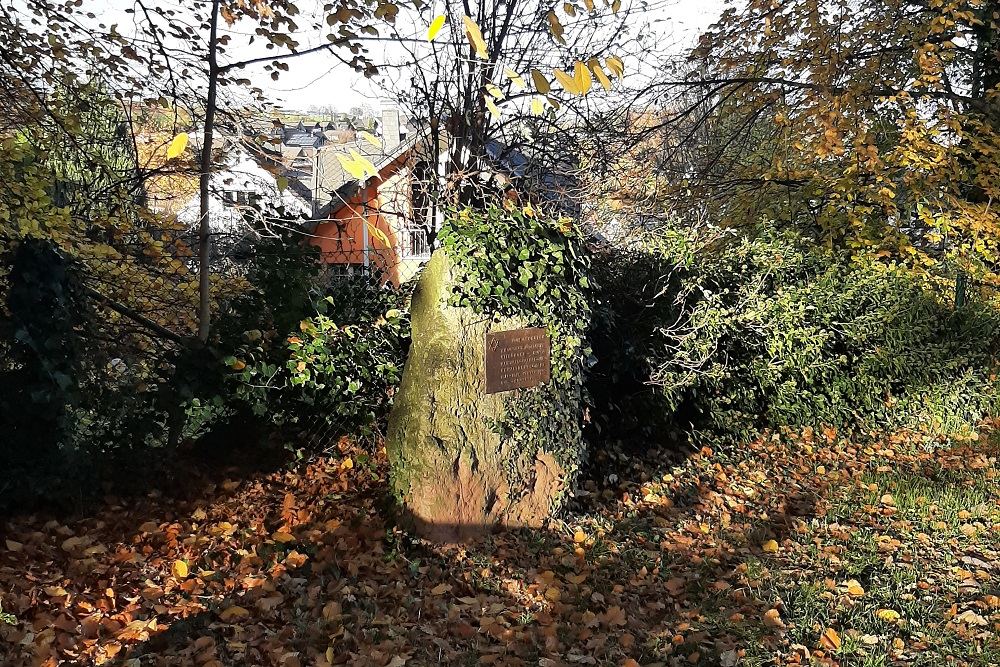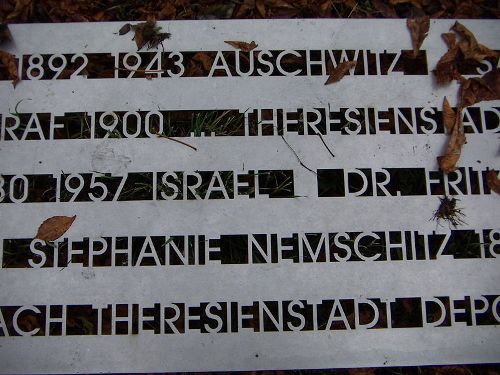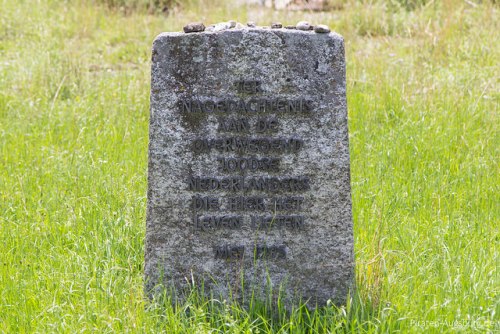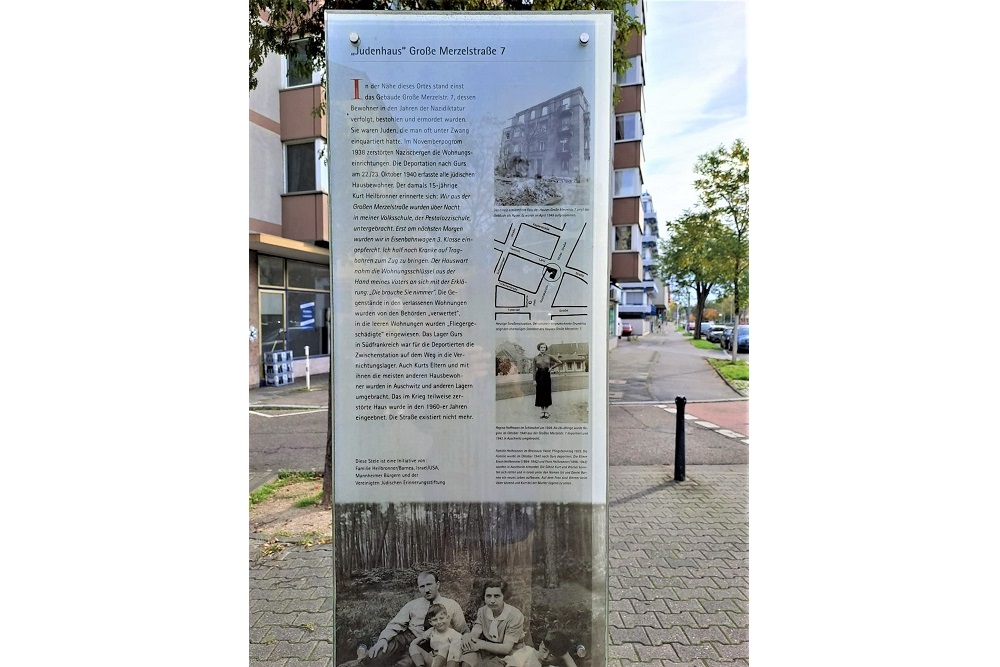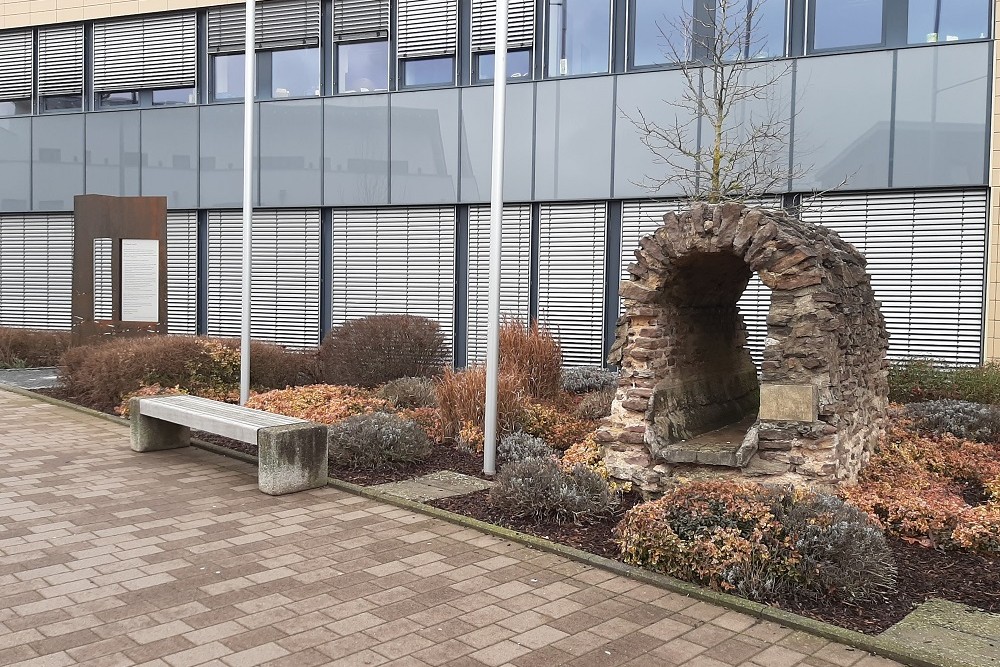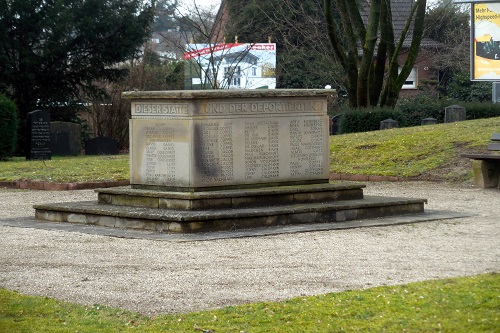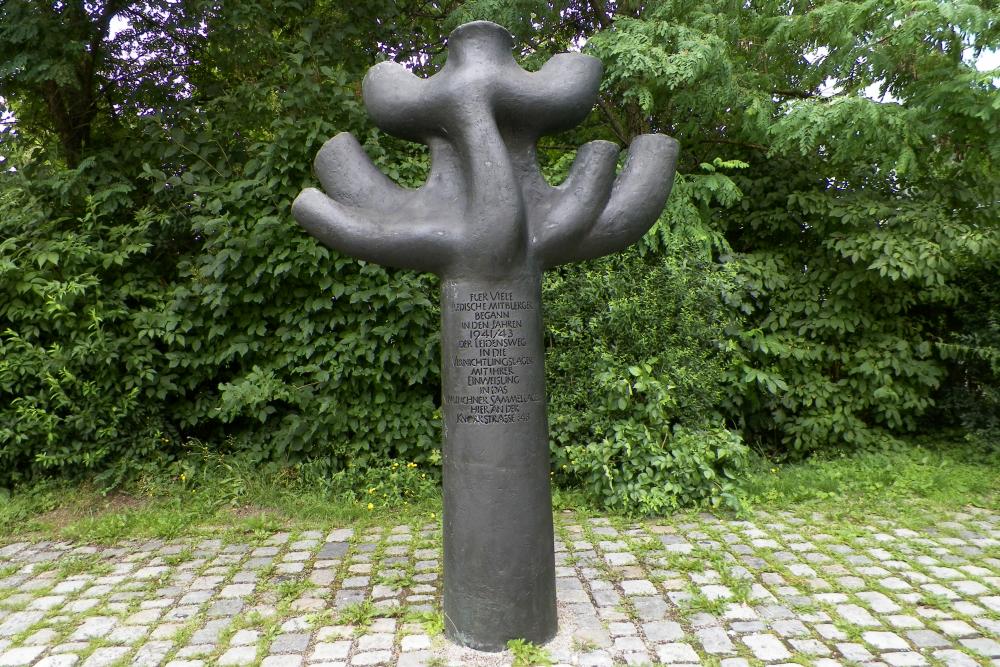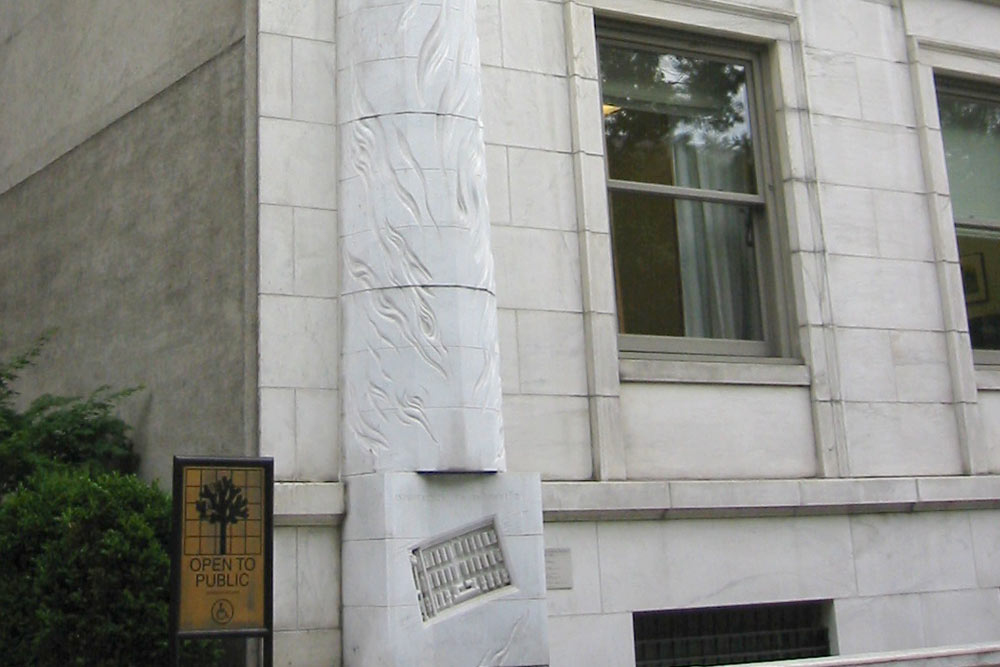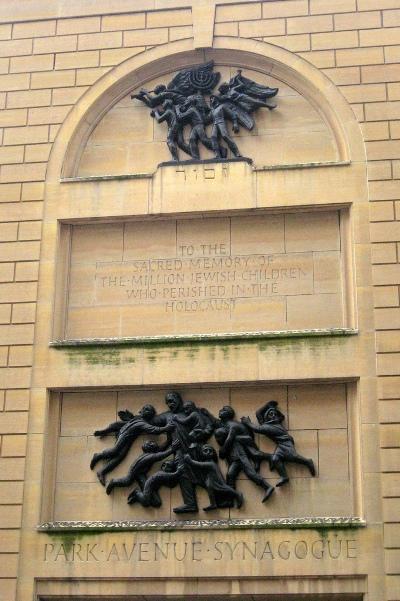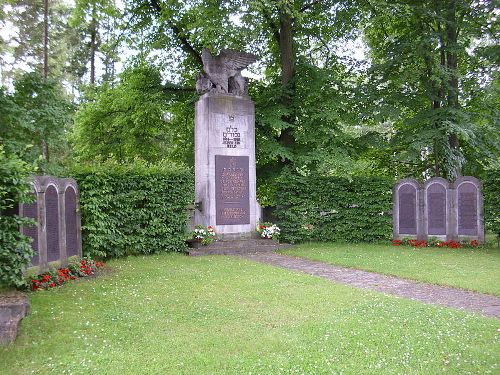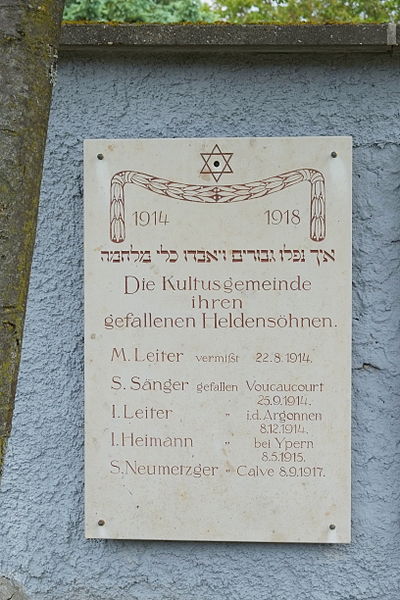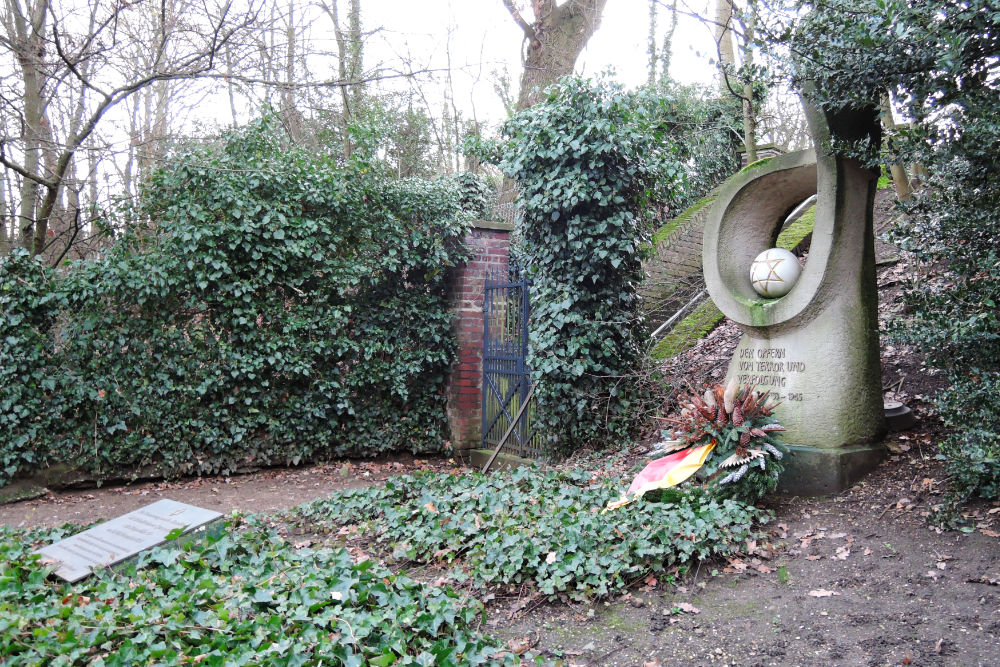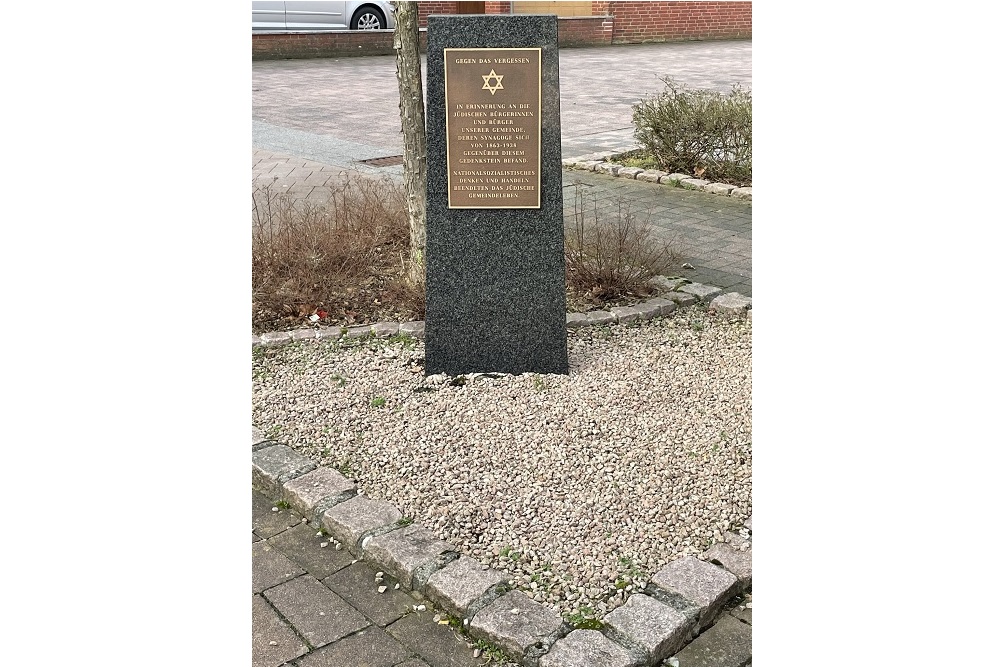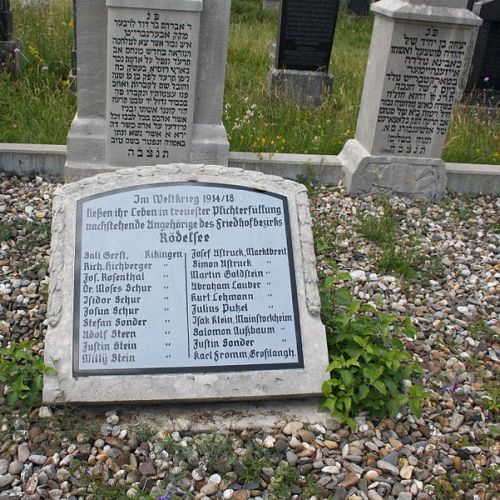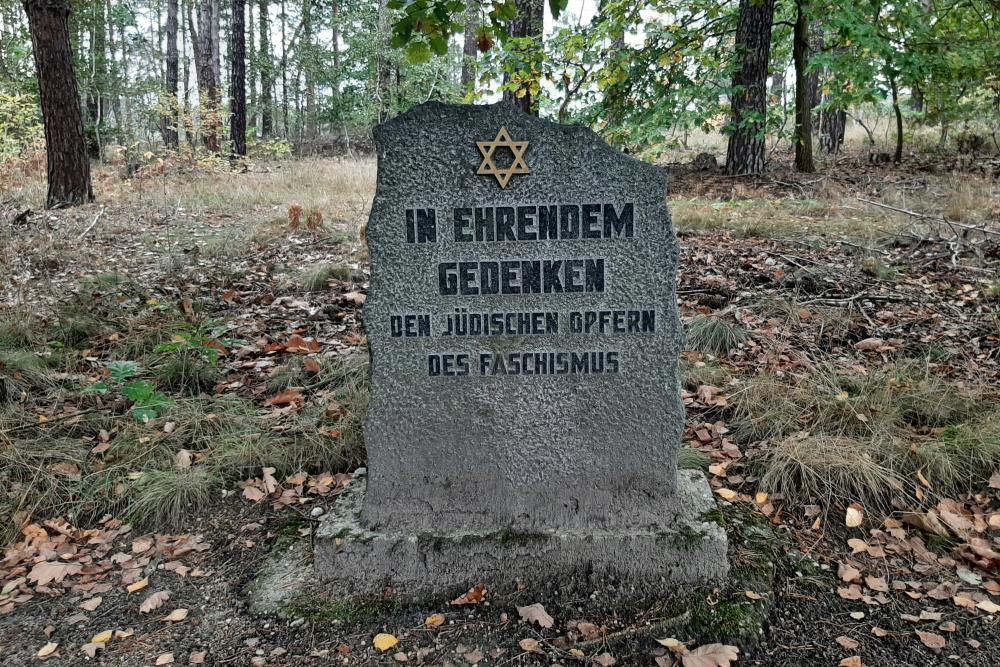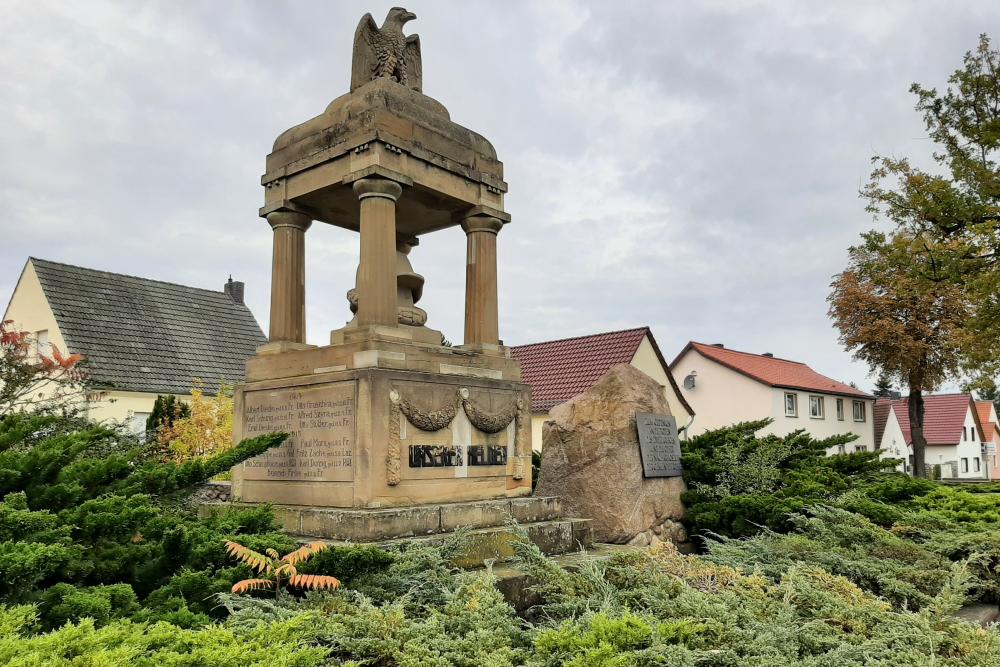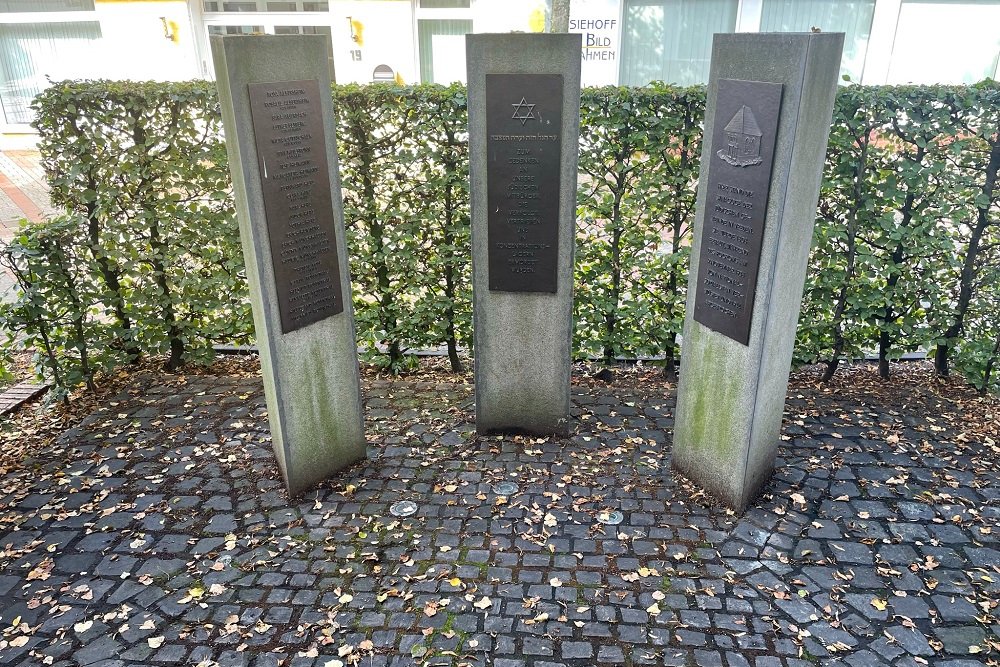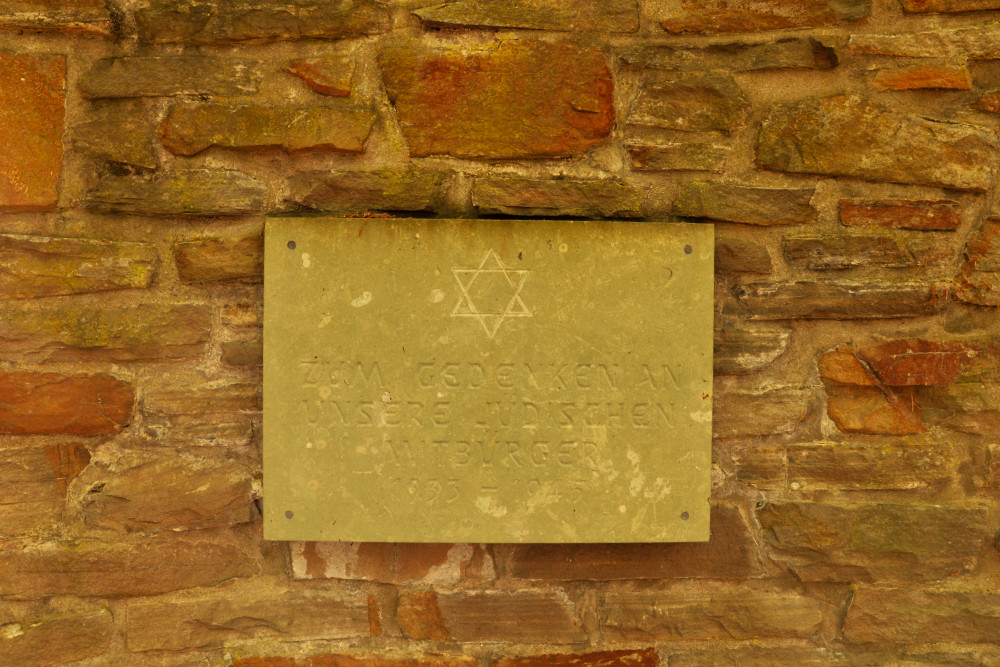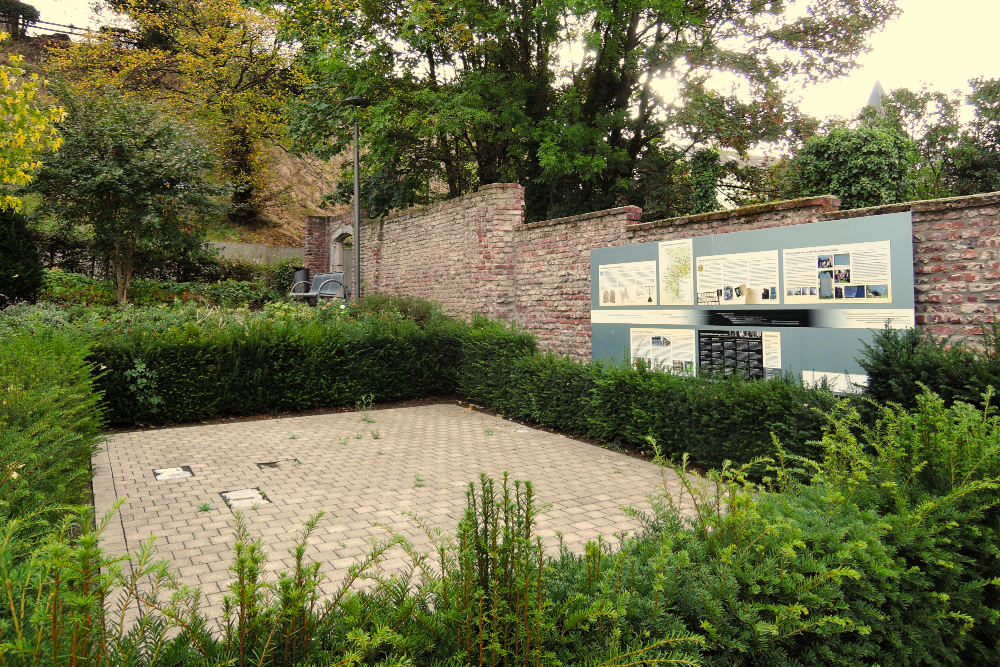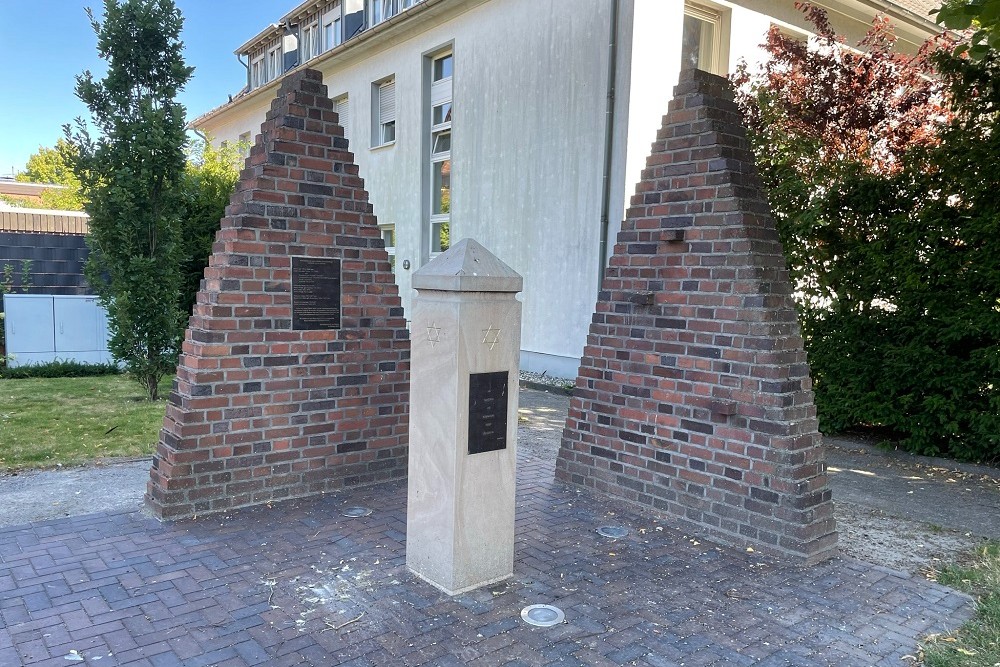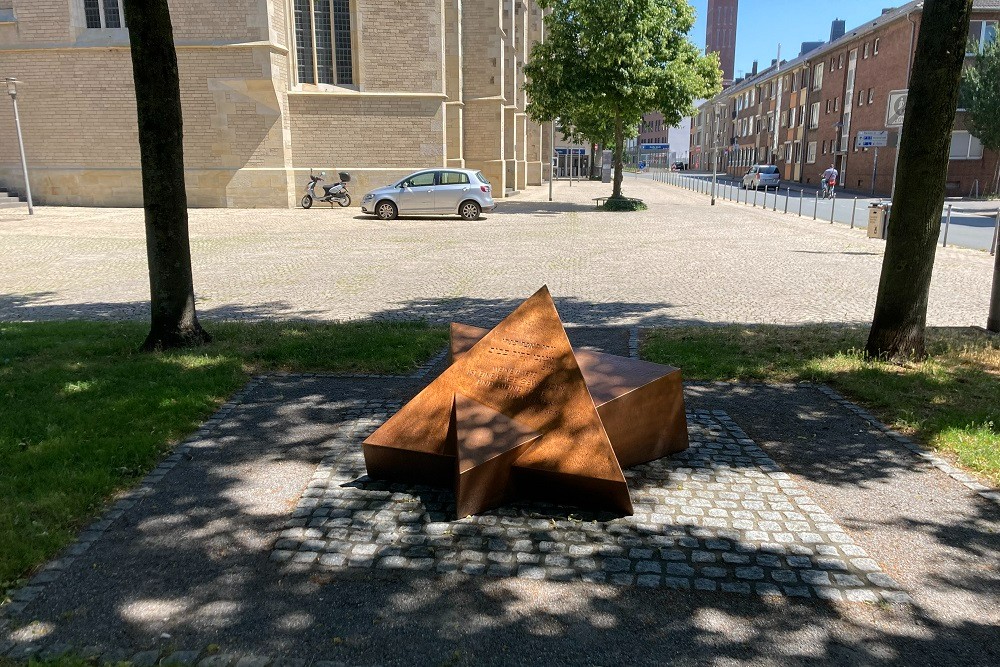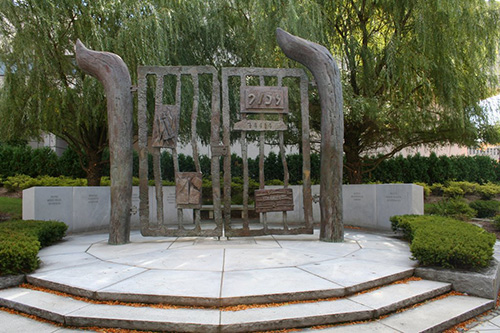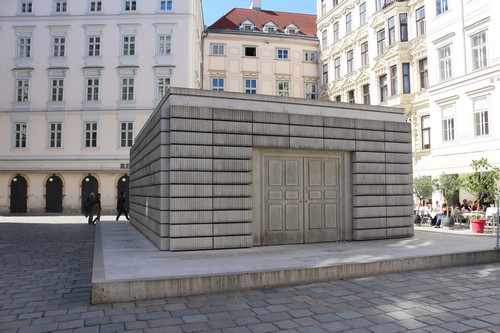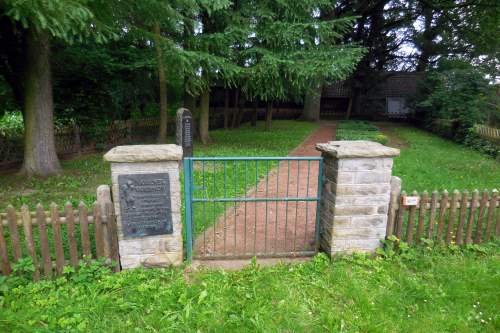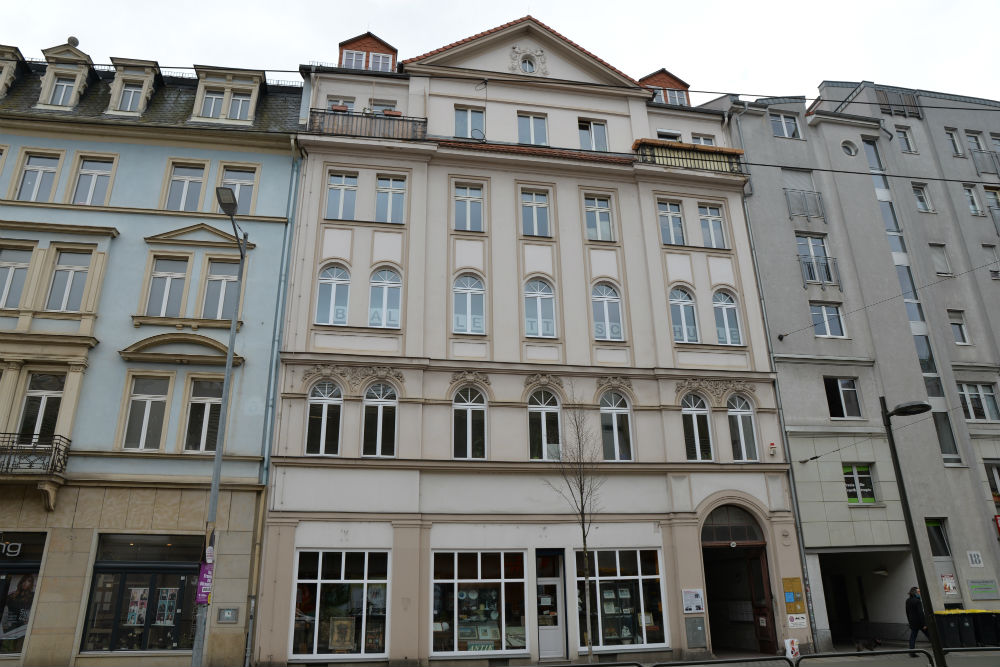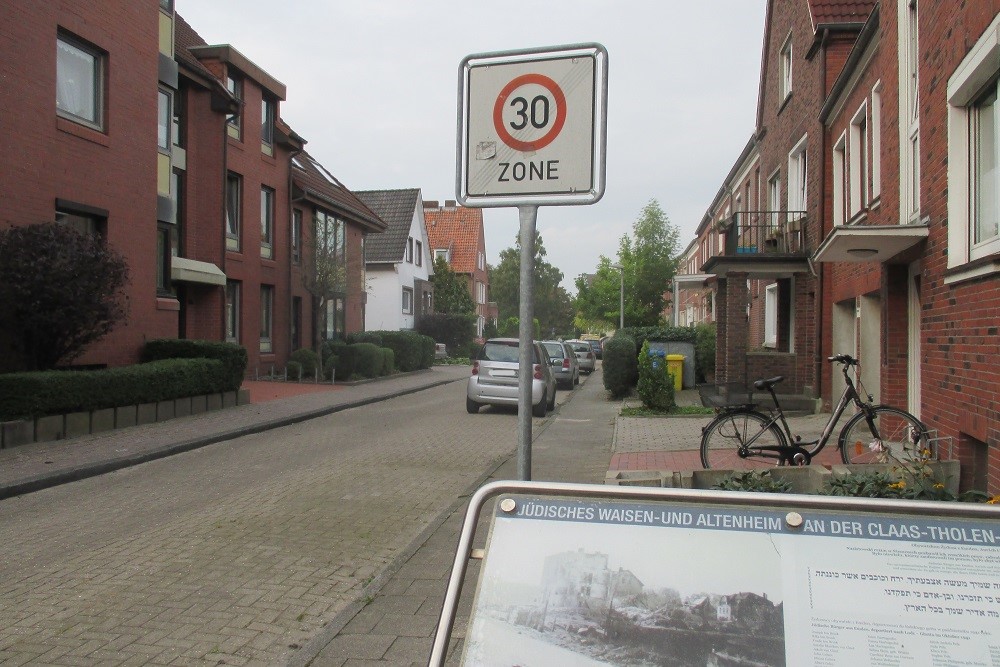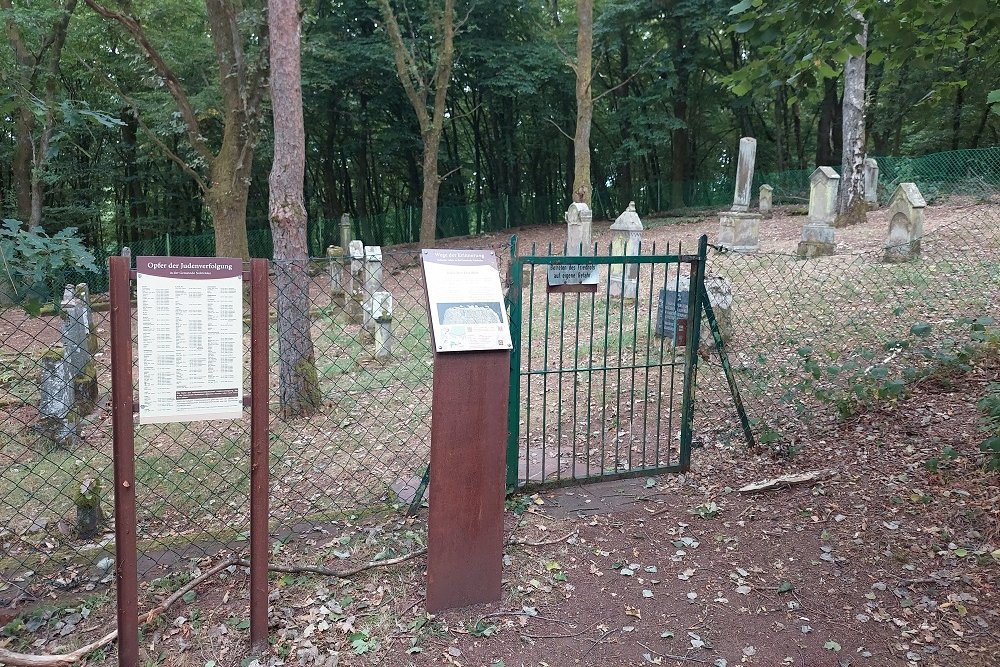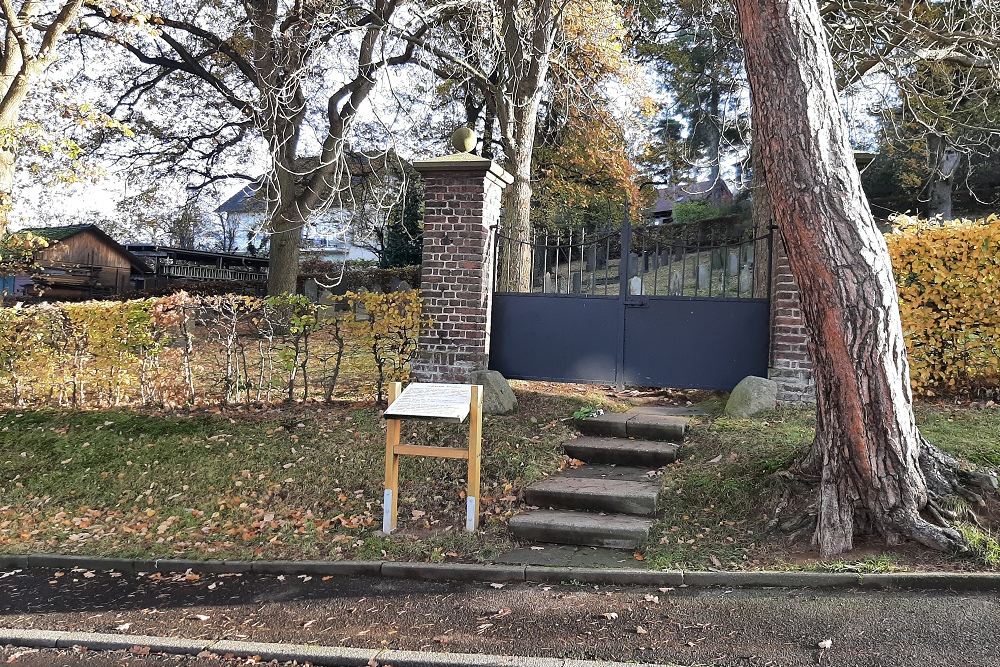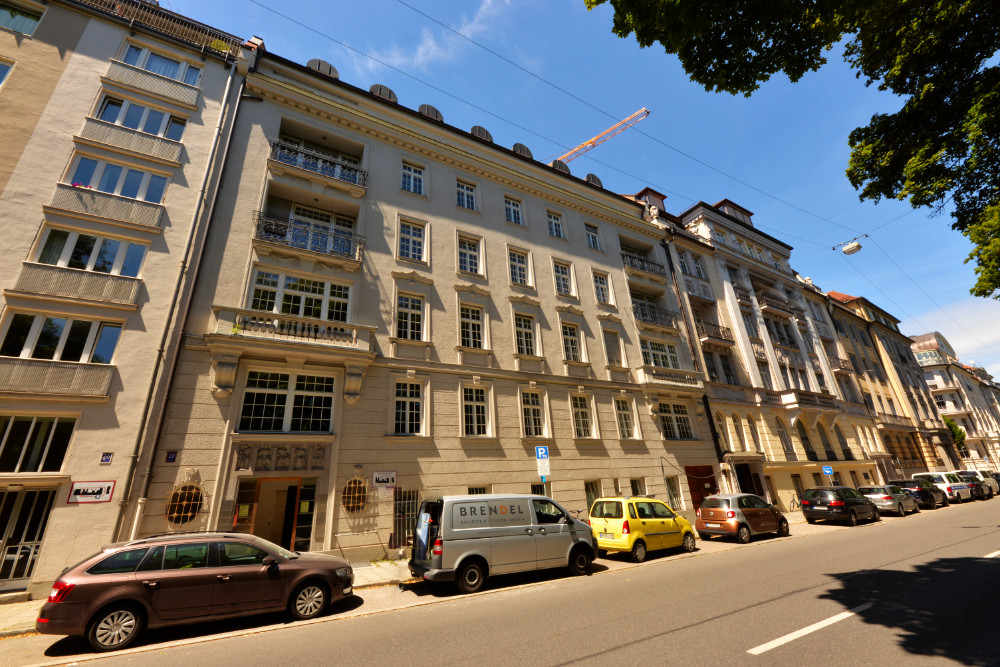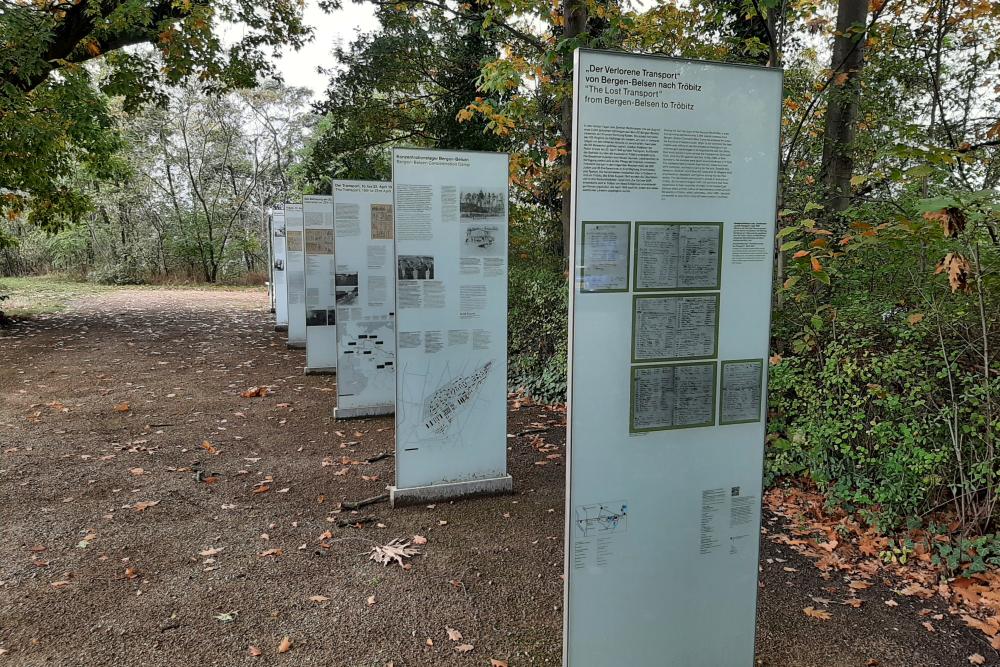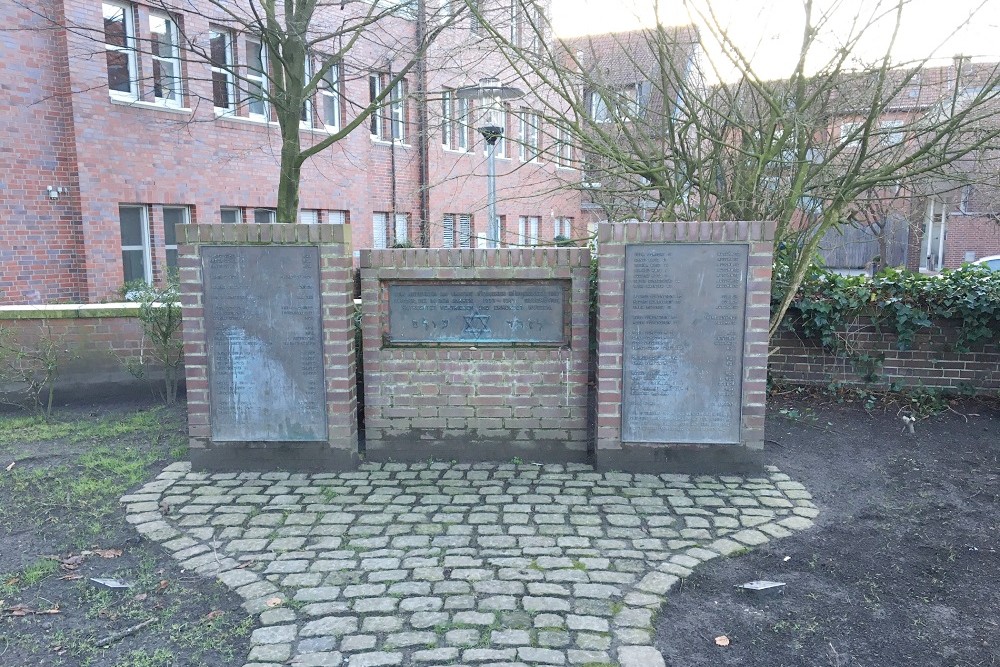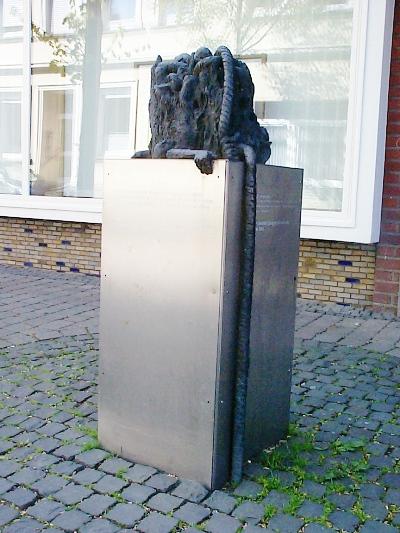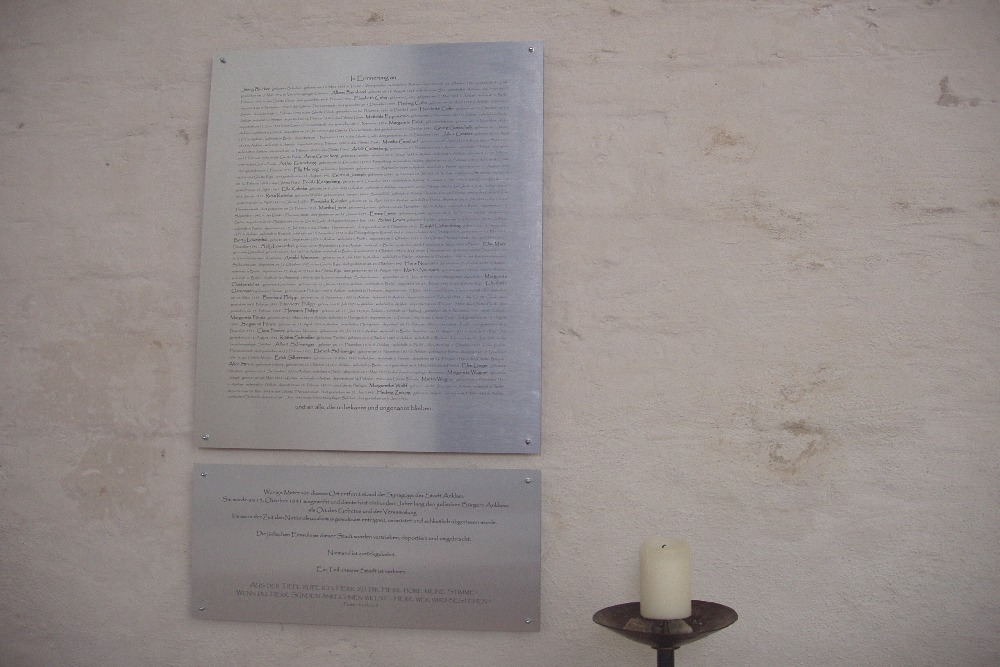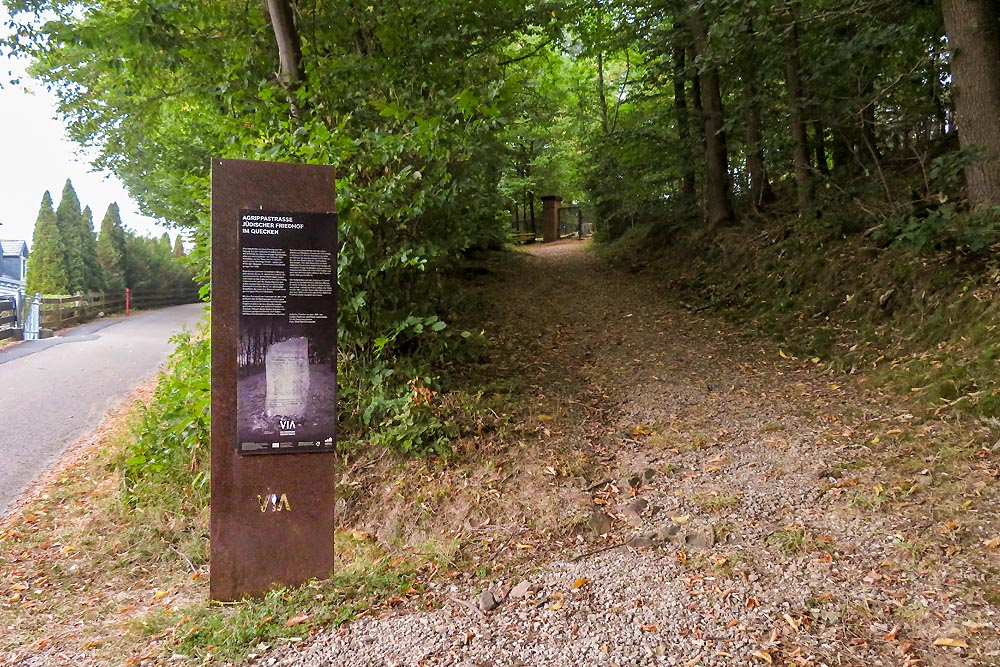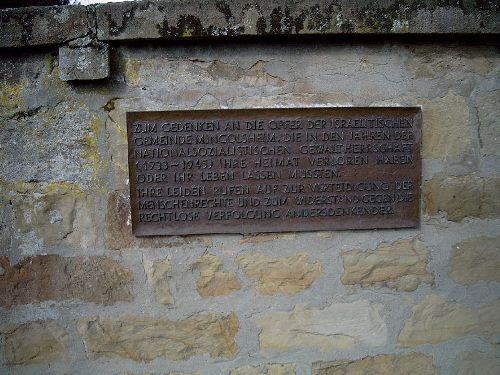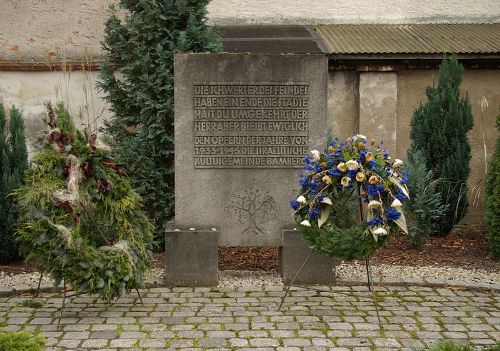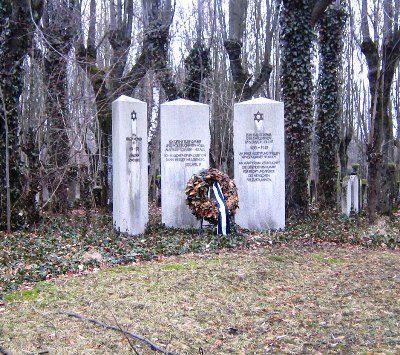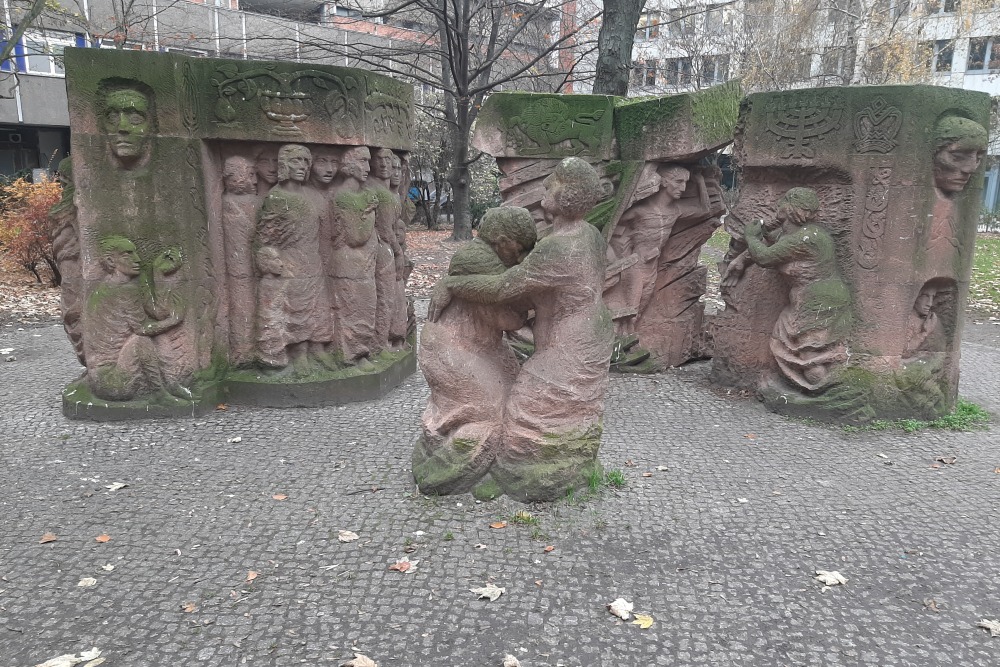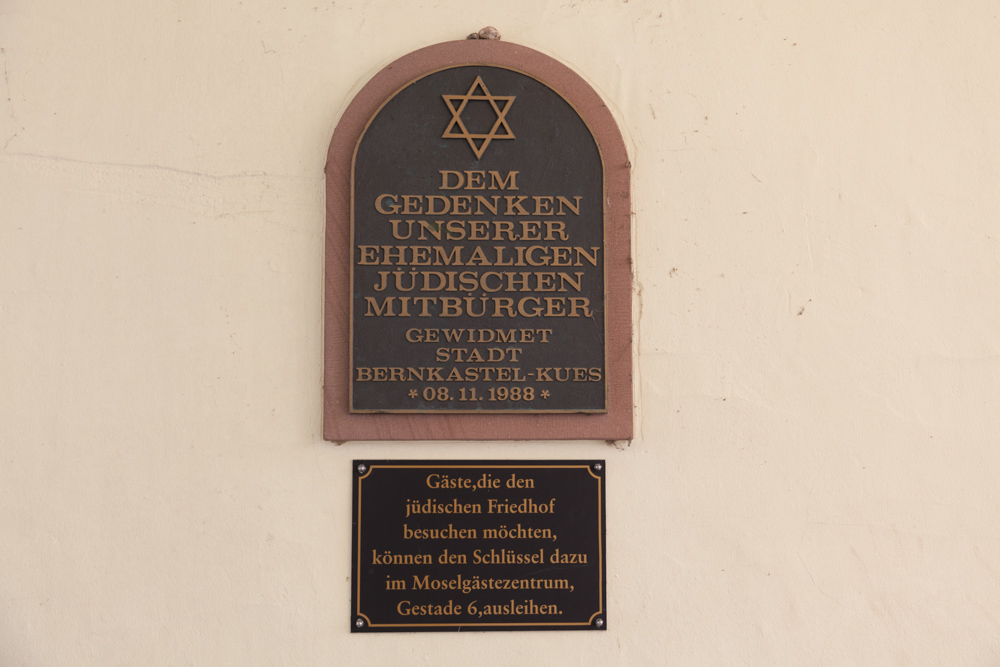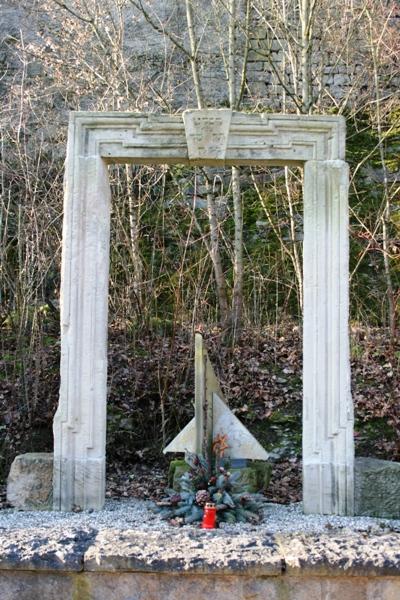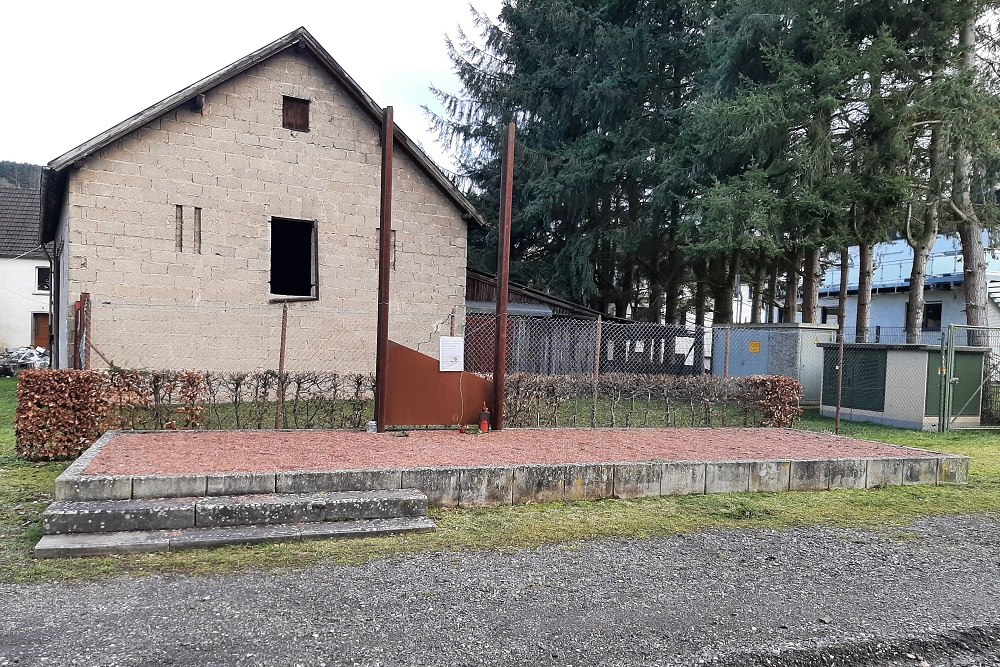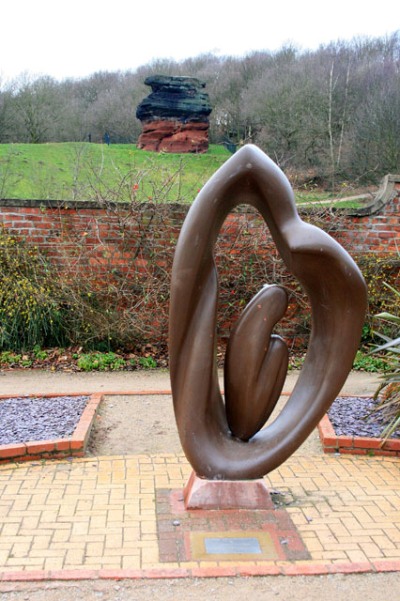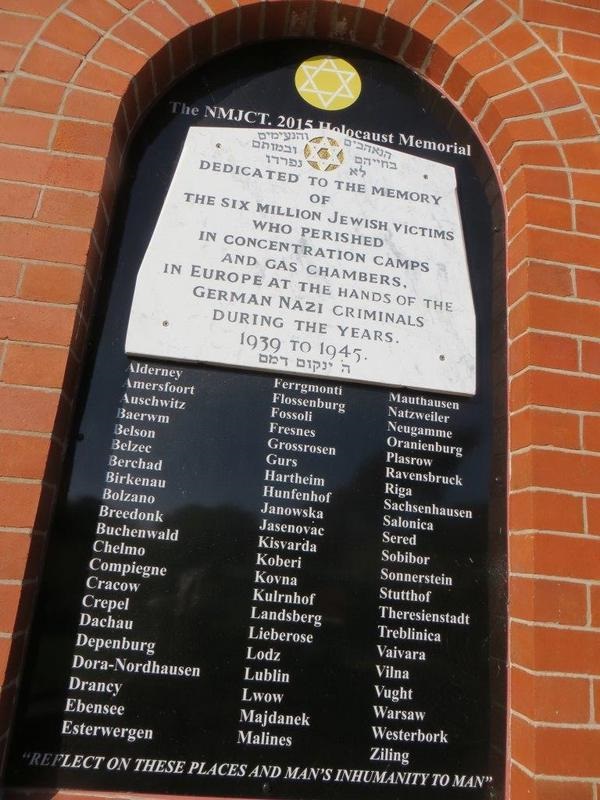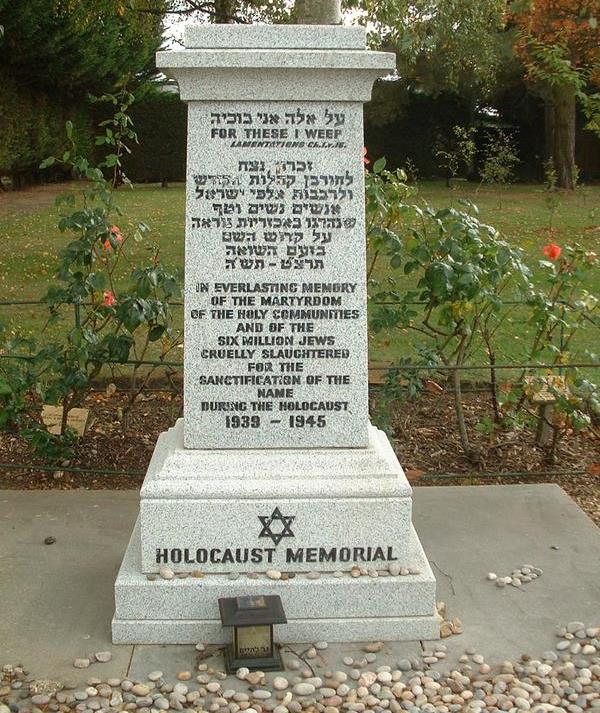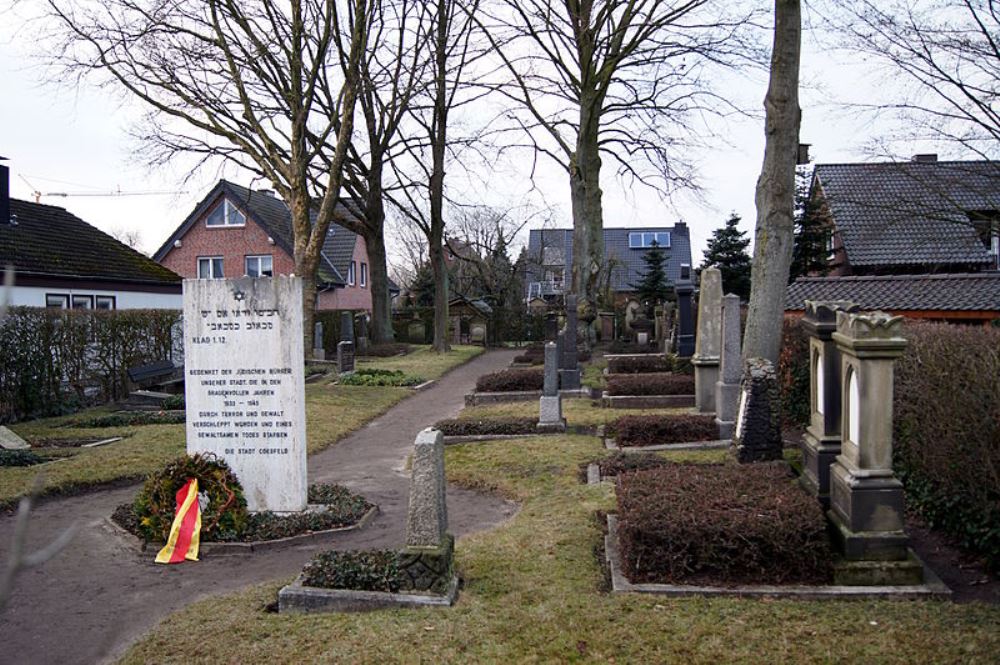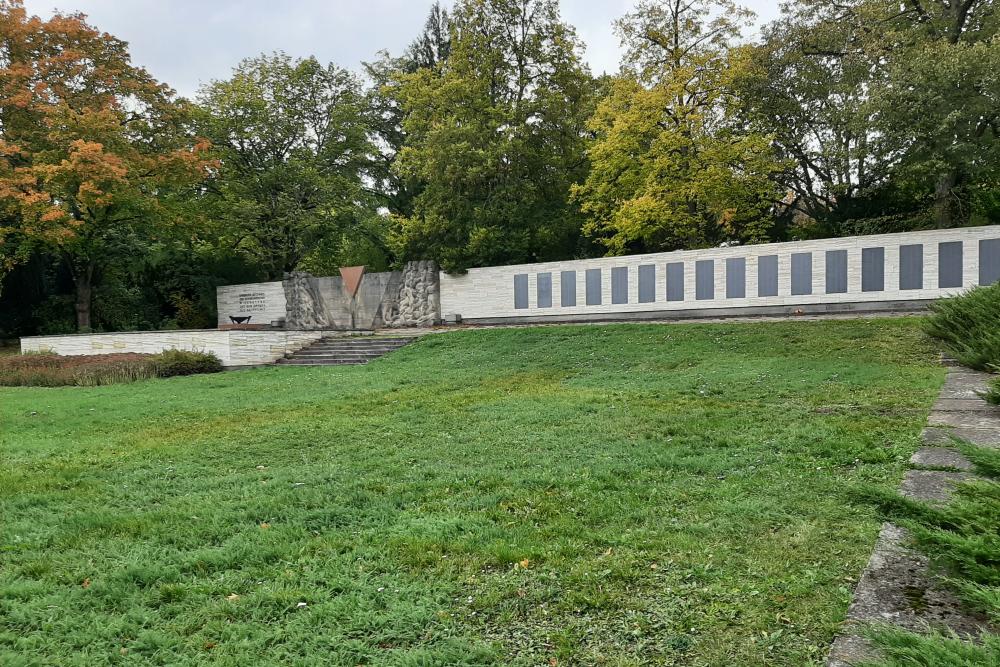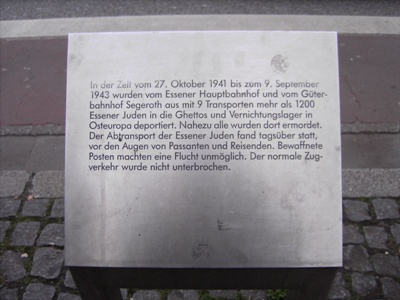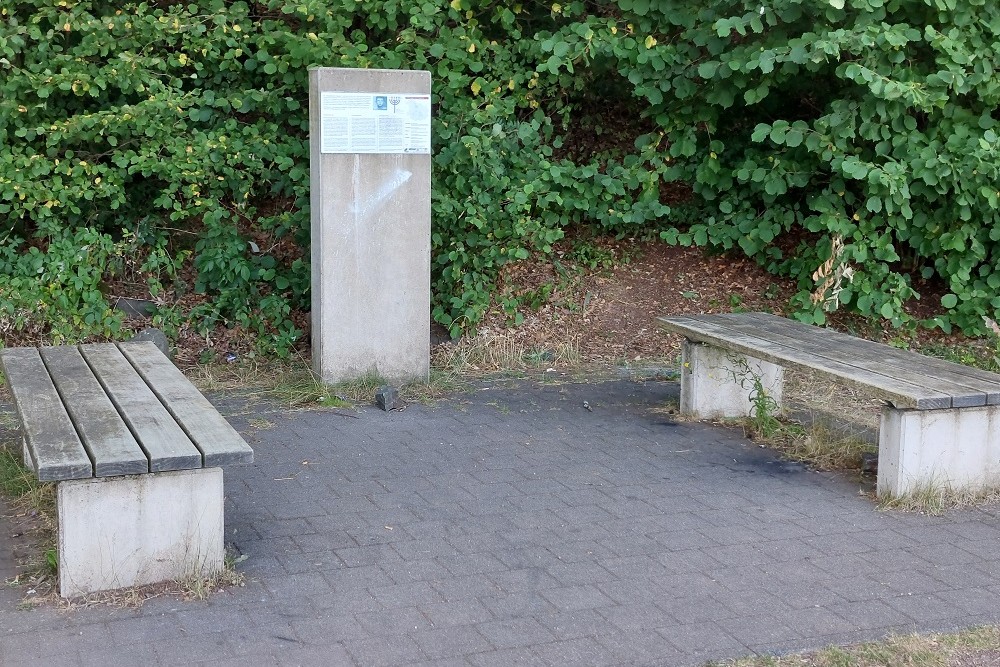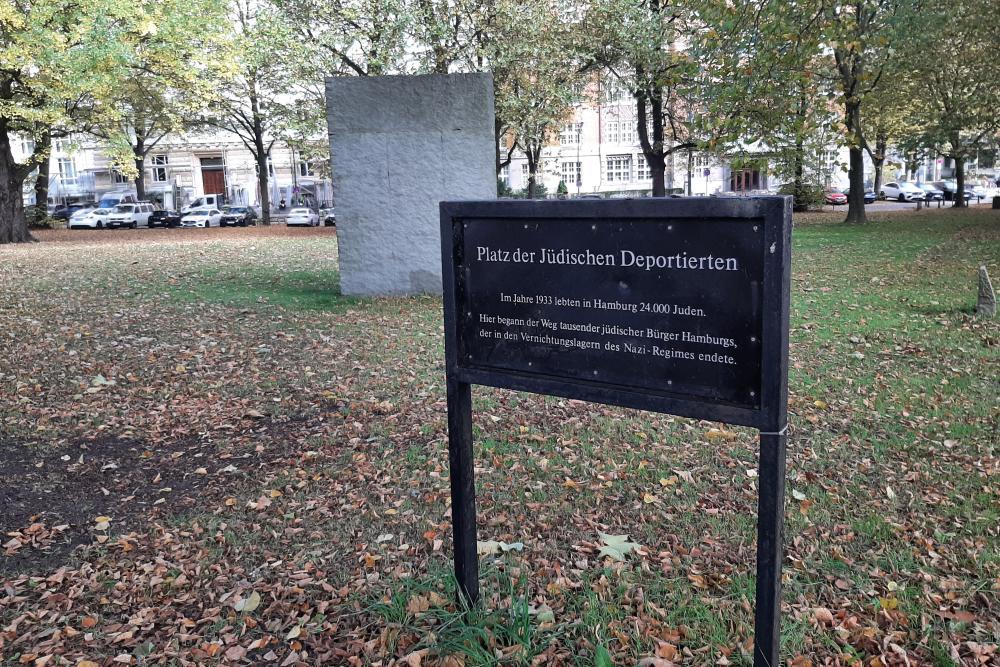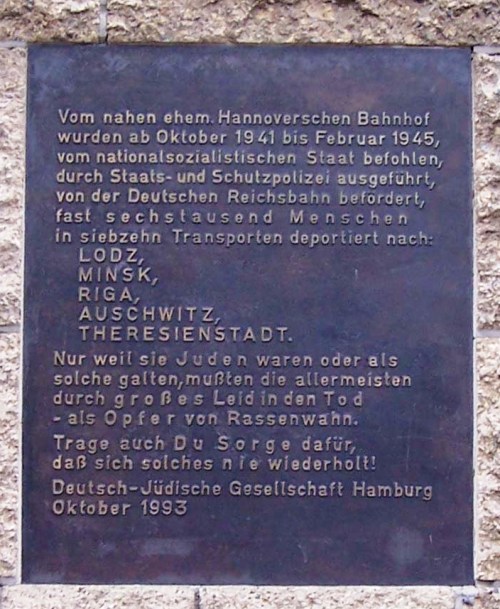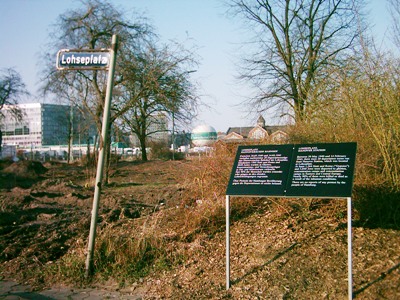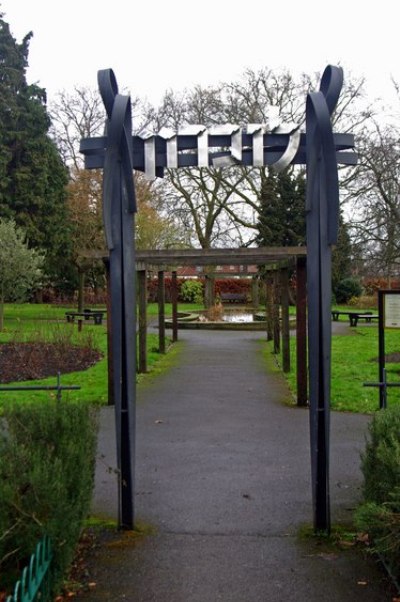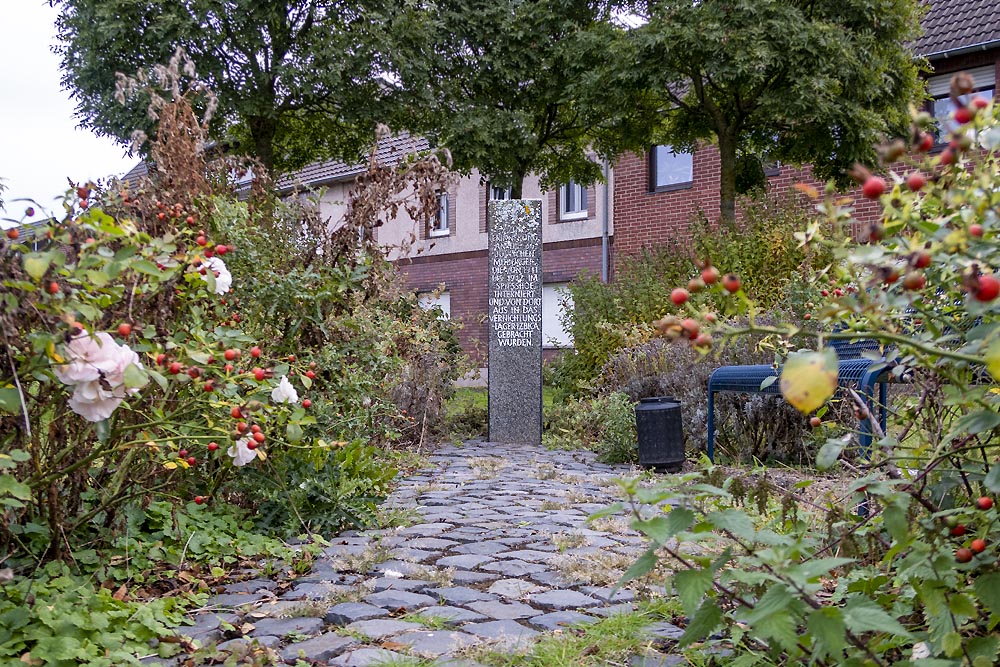Introduction
Wir haben es nicht gewusst
When asked about their knowledge about the extermination of 6 million Jews by the Nazis, many Germans answered that they did not know about it (Wir haben es nicht gewusst). However, millions of them openly voted for the anti-Semitic Nazi party in 1933, and therefore founded the basis for what is now commonly known by the term Holocaust. What did the German population really know about the fate of the Jews and what was their opinion about it?
Justify
On 16 June 1943, Wehrmacht officer Wilm Hosenfeld wrote in his diary "Countless Jews were killed, without reason, pointless, without even thinking about it". He was stationed in Warsaw, where during springtime, the last remaining Jews in the ghetto rebelled against the Germans, because they refused to be deported to the gas chambers like tame sheep. Hosenfeld knew the fate of the Jews being deported from Warsaw. Already in April 1942 he wrote about the gassing of Jews. "Now the last Jews in the ghetto have been exterminated", he wrote in his diary. "By committing this heinous mass murder of the Jews, we have lost the war. [...] We deserve no mercy, we are all guilty."
Not only knew Hosenfeld that the Jews were being exterminated, he also expressly condemned it. By saving two Jews he put his words into action. This heroic deed was the basis for the film "The Pianist" (2002). On 16 February 2009, the Holocaust institute Yad Vashem (Israel) awarded him with the title Righteous Among the Nations. By 1 January 2009, Yad Vashem rewarded 460 Germans with the same title. A poor number, compared to the Netherlands and Poland, where respectively 4,947 and 6,135 civilians were awarded the title Righteous Among the Nations. There was hardly any active resistance against the persecution of Jews in Germany, but that doesn’t mean that the German people massively and without reservation approved the government policy against Jews. The attitude of the Germans was more versatile than one would expect in a dictatorship.
Definitielijst
- dictatorship
- A form of government where the power in a country is in the hands of one person, the dictator. Originally a Roman regime in case of an emergency where total power would rest with one person during six months in order to face a crisis.
- ghetto
- Part of a town separated from the outside world to segregate Jewish population. The establishment of ghettos was intended to exclude the Jews from daily life and from the rest of the people. From these ghettos it was also easier to deport the Jews to the concentration and extermination camps. Also known as “Judenviertel” or Jewish quarter.
- Holocaust
- Term for the destruction of European Jewry by the Nazis. Holokauston is the Greek term for a completely burnt sacrifice.
- Jews
- Middle Eastern people with own religion that lived in Palestine. They distinguished themselves by their strong monotheism and the strict observance of the Law and tradition. During World War 2 the Jewish people were ruthlessly persecuted and annihilated by the German Nazis. . An estimated 6,000,000 Jews were exterminated.
- Nazi
- Abbreviation of a national socialist.
- resistance
- Resistance against the enemy. Often also with armed resources.
- Wehrmacht
- German armed military forces, divided in ground forces, air force and navy.
- Yad Vashem
- Yad Vashem is Israel’s national Holocaust memorial where in addition to Jewish victims and resistance heroes, also non-Jewish helpers of Jews during the World War 2 are being honoured. Those non-Jewish are called the Righteous Among The Nations. Until the mid 90’s trees were planted for these rescuers. In 1996 a special remembrance garden was established displaying all of the names of the helpers. Every year new names are added.
Images
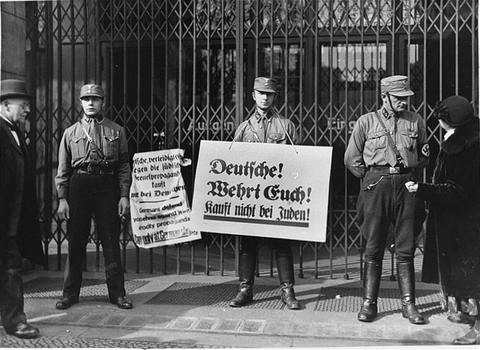 Brownshirts of the SA block a shop with a Jewish owner. On the boards they warn the people not to buy in Jewish shops. Source: U.S. Holocaust Memorial Museum.
Brownshirts of the SA block a shop with a Jewish owner. On the boards they warn the people not to buy in Jewish shops. Source: U.S. Holocaust Memorial Museum.Build-up towards the extermination of the Jews
Kristallnacht
The anti-Semitism of the NSDAP [commonly referred to in English as the Nazi Party] was not something that could be overlooked by the ordinary German citizen. The Jews were explicitly excluded from German citizenship in the party programme. In "Mein Kampf" Hitler referred to the Jews as "a seed of decay in people and races, in a broader sense, the destroyer of human culture." Although the anti-Semitic viewpoints in general were not the most important reason to support the NSDAP, they seldom were the reason not to do so. In search for a scapegoat for the defeat in the First World War and the economic depression, these viewpoints were shared among a large part of German society.
Especially members of the Sturmabteilung (SA) openly discriminated and were violent against Jews in the first months after the take-over of power in 1933. The most violent street violence ended after the Night of the Long Knives, when the power of the SA was brutally suppressed. To prevent Germany from being harmed internationally in the field of politics and economics, anti-Jewish acts of violence were being prevented from taking place for the time being. Anti-Semitic laws, such as the Nuremberg Race Laws of 1935, came into place. The German people did not really object to these laws, which among other things excluded Jews from civil rights.
The violence against the Jews in Germany escalated in the night of 9 to 10 November 1938, which became known as the Kristallnacht (literary Cristal Night, better known as Night of the Broken Glass). After a German diplomat was murdered by a young Jewish fugitive at the embassy in Paris, propaganda minister Joseph Goebbels stirred up the party members to take revenge. Everywhere in Germany party activists massively took to the streets, destroying Jewish stores and setting synagogues on fire. It is estimated that 236 Jews died that night as a result of the Nazi violence. Many others committed suicide. Again, the aggression was mainly expressed by SA members. However, at several locations bystanders had taken part in the plundering and encouraged the crime committers. "Throw those Jews in the fire!" a woman supposedly yelled when the Nuremberg synagogue was on fire. A large part of the German population, however, condemned the act of violence. According to a Jewish emigrant in Munich "the sentiment among Christian residents of Munich […] is fully against the action." He received support and sympathy from all sides.
According to a report from the Sicherheitsdienst [Security Service] regarding the sentiment among the German population "many were of the opinion that they openly had to defend the Jews. The destruction of the synagogues was deemed unjustified." Economic considerations weighed heavier than human considerations. "A majority, especially among the rural population, regrets that the actions have caused the destruction of valuable goods, that […] could have benefited the community", according to a government report from the Lower-Franken region. This viewpoint was shared by Nazi heavyweights, such as Hermann Göring, who called on civilians to be frugal and collect empty toothpaste tubes and rusty nails for reuse. In the future, public assault against the Jews would therefore be abandoned in Germany.
Euthanasia programme
After the Kristallnacht it would take another three years until the Jews would become the victim of mass murder. The mentally and physically disabled were the first victims of the morbid craving for destruction by the Nazis. Between October 1939 and August 1941 between 70,000 and 100,000 mental patients were killed in the name of the euthanasia programme of the Nazis. Family members were being lied to that the patient had died from pneumonia or another disorder. The high death rates aroused suspicion and the euthanasia programme could no longer be kept secret. Especially within religious circles protest movements started.
One of the leaders of the protest was Clemens von Galen, the bishop of Münster, who on 3 August 1941 held his famous anti-euthanasia speech. In it, he opposed against the violation of the fifth commandment – "Thou shalt not kill" – and warned his audience that the murder of "helpless mental patients" could become a permit for "murder of all unproductive people", including elderly, work invalids and heavily injured soldiers. "Then nobody is sure of their lives", he declared. Such criticism was bad timing for Hitler, now that Germany had been at war with the Soviet Union since June 1941, and it was extremely important that the German people unanimously supported their Führer . On 24 August 1941, Hitler therefore ordered that the euthanasia programme be stopped, although the killing of handicapped continued in the concentration camps and in the occupied countries of Eastern Europe. However, it was clear that although Nazi Germany was still under dictatorship, the public opinion also had to be taken into account.
Propaganda
When Jews in Germany were ordered to wear a Star of David on 1 September 1941, the reactions were as diverse as after Kristallnacht. Once he was recognisable as a Jew, journalist and writer Victor Klemperer was accused "Why are you still alive, bastard?". But at the same time, there were many Germans, often complete strangers, who out of sympathy would shake his hand on the street. Such expressions of sympathy were no exception, because at the end of October 1941, the Reichssicherheitshauptamt deemed it necessary to arrest persons who were friendly to Jews in whatever manner, and to imprison them in a concentration camp.
Nazi propaganda had to convince the German people of the danger of Jews for German society. Children were brought up with the hate for Jews, for instance by the picture book "Der Giftpilz" (the poisonous mushroom), published by the furious Jew hater Julius Streicher, who was also the publisher of the anti-Semitic weekly magazine "Der Stürmer". "Just as it is often very difficult to distinguish between poisonous and non-poisonous mushrooms, just as difficult is it to distinguish between a Jew and a swindler or criminal", children were taught. Adults were indoctrinated by means of large-scale propaganda films, such as "Jud Süss" from 1940. In the film, the 18th-century Prince Karl Alexander, duke of Württemberg, was financially swindled by his financial adviser, the Jew Joseph Süss Oppenheimer, who was also guilty of raping German girls. In 1943, the film had already been watched by 20.3 million people. The also in 1940 released film "Der Ewige Jude" was watched by far less people, but through posters and flyers the Germans were massively confronted with images from the film in which Jews were compared to rats. "Where rats turn up, deceases spread and destruction takes place. They are cunning, cowardly and mostly operate in a large group – no different from the Jews among the people", according to an accompanying text.
Definitielijst
- concentration camp
- Closed camp where people are being held captive that are considered to be anti- social, enemies of the state, criminal or unwanted individuals. These groups mostly do not get a fair trial or are condemned to doing time in a camp.
- destroyer
- Very light, fast and agile warship, intended to destroy large enemy ships by surprise attack and eliminating them by using torpedoes.
- dictatorship
- A form of government where the power in a country is in the hands of one person, the dictator. Originally a Roman regime in case of an emergency where total power would rest with one person during six months in order to face a crisis.
- First World War
- Took place from 1914 till 1918 and is also named The Great War. The conflict started because of increased nationalism, militarism and neo-colonialism in Europe. Two alliances battled one another during the 4-year war, which after a dynamic start, resulted into static trench warfare. The belligerents were the Triple Alliance (consisting of Great-Britain, France, and Russia; later enlarged by Italy and the USA, amongst others) on the one hand and the Central Powers (consisting of Germany, Austria-Hungary, Bulgaria and the Ottoman empire) on the other hand. The war was characterized by the huge number of casualties and the use of many new weapons (flamethrowers, aircraft, poison gas, tanks). The war ended in 1918 when Germany and its allies surrendered unconditionally.
- Führer
- German word for leader. During his reign of power Adolf Hitler was Führer of Nazi Germany.
- Jews
- Middle Eastern people with own religion that lived in Palestine. They distinguished themselves by their strong monotheism and the strict observance of the Law and tradition. During World War 2 the Jewish people were ruthlessly persecuted and annihilated by the German Nazis. . An estimated 6,000,000 Jews were exterminated.
- Kristallnacht
- The night of 9-10 November 1938. Over 250 German synagogues were destroyed. Tens of thousands of Jews were arrested.
- Mein Kampf
- “My Struggle”. Book written by Adolf Hitler, outlining the principles of National Socialism.
- Nazi
- Abbreviation of a national socialist.
- Night of the Long Knives
- Night of 30 June to 1 July 1933 during which Hitler killed many of the demanding leaders of the SA, including Ernst Röhm.
- propaganda
- Often misleading information used to gain support among supporters or to gain support. Often used to accomplish ideas and political goals.
- Soviet Union
- Soviet Russia, alternative name for the USSR.
- Sturmabteilung
- Storm detachment. Semi-military section of the NSDAP. Founded in 1922 to secure meetings and leaders of the NSDAP. Their increasing power was stopped during “The night of the long knives”, 29 and 30 June 1934.
- synagogue
- Jewish house of prayer.
Images
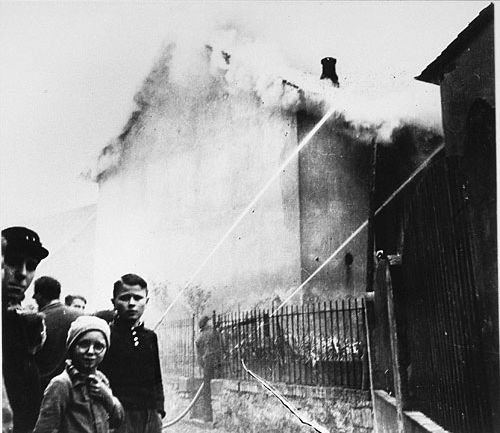 While the synagogue in Ober-Ramstadt is on fire in the morning after the Kristallnacht residents are watching. Firemen prevent the fire from spreading to neighbour buildings. Source: U.S. Holocaust Memorial Museum.
While the synagogue in Ober-Ramstadt is on fire in the morning after the Kristallnacht residents are watching. Firemen prevent the fire from spreading to neighbour buildings. Source: U.S. Holocaust Memorial Museum.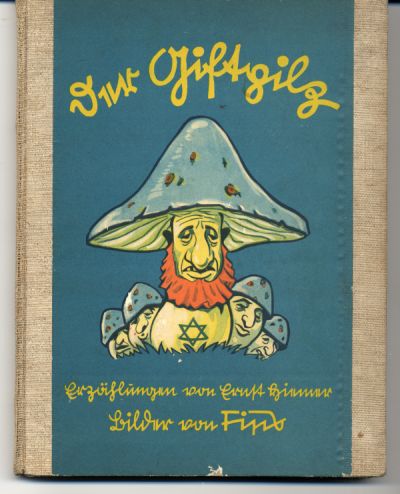 Cover of the antisemitic picture book Der Giftpilz. Source: Randall Bytwerk Collection.
Cover of the antisemitic picture book Der Giftpilz. Source: Randall Bytwerk Collection.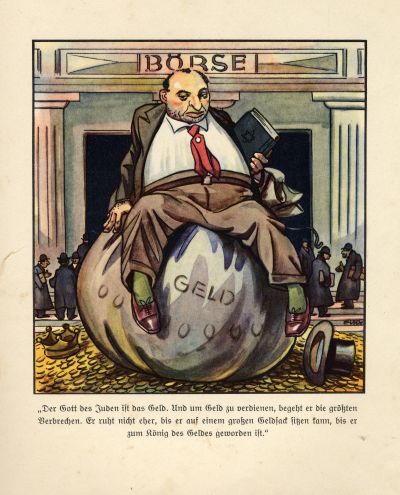 Picture in Der Giftpilz: "The God of the Jews is money. And to earn money he commits the biggest crimes. He doesn’t rest till he can sit on a large moneybag, till he became the king of money." Source: Randall Bytwerk Collection.
Picture in Der Giftpilz: "The God of the Jews is money. And to earn money he commits the biggest crimes. He doesn’t rest till he can sit on a large moneybag, till he became the king of money." Source: Randall Bytwerk Collection.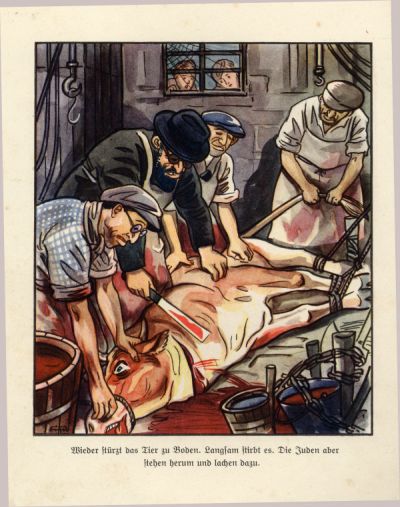 Picture in Der Giftpilz: "The animal falls down on the ground. Slowly it dies. The Jews are surround it and laugh about it. Source: Randall Bytwerk Collection.
Picture in Der Giftpilz: "The animal falls down on the ground. Slowly it dies. The Jews are surround it and laugh about it. Source: Randall Bytwerk Collection.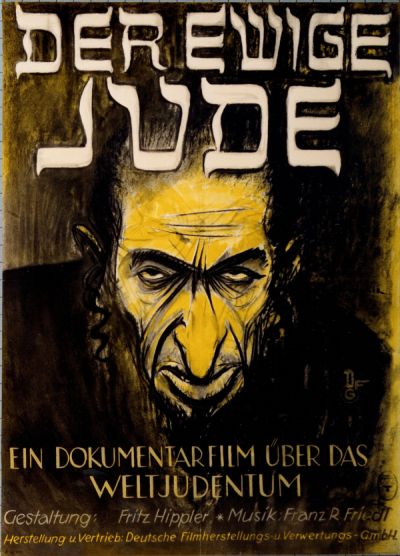 Advertising poster for the anti-Semitic movie Der Ewige Jude. Source: U.S. Holocaust Memorial Museum.
Advertising poster for the anti-Semitic movie Der Ewige Jude. Source: U.S. Holocaust Memorial Museum.Knowledge of the extermination
Einsatzgruppen
With the invasion of the Soviet Union, the Jews were portrait in Nazi propaganda as the driving force behind the communist regime in that country. In the wake of the Wehrmacht the Einsatzgruppen [task forces] followed, and murdered 800,000 Jews in the east during the first year of the campaign. The fact that the Nazi propaganda influenced the soldiers on the east front, is clear from diary notes and letters to the home front. SS-Obersturmführer Karl Kretchner, member of Einsatzgruppe C, wrote on 27 September 1942 to his wife that he and his "comrades were literally fighting for the survival of our people. […] Since the war is a Jewish war in our eyes, the Jews will be first targeted. Here in Russia, where the German soldier is, no Jew will remain."
Such viewpoints not only manifested themselves among the members of the killing units of the SS. A front soldier wrote in a letter home "The big task that lies upon us in the fight against Bolshevism is the extermination of the eternal Jews". "If only you could see what the Jews did to Russia, then you would really understand why the Führer engaged in battle with the Jews. What sorrow would have come upon our mother country if these beasts would have gotten the upper hand?"
Mass executions often took place in public, often under the watchful eye of the Wehrmacht soldiers looking for a distraction. There were even men who took pictures of it and showed them at home as if it were holiday pictures. That was precisely what the commander of a workshop of the Waffen-SS in Ukraine, SS-Sturmführer Max Täubner did. It was one of the indictments he stood trial for in 1943 before the SS and police courts in Munich. "By taking pictures of the incidents […] and showing them to his wife and friends, the suspect is guilty of disobedience", concluded the courts. "Such pictures can be of extreme risk for the security of the Reich if they fall in the wrong hands. They could easily leak out from South Germany to Switzerland and be used for enemy propaganda." The defendant was found guilty of this and other charges and was sentenced to 10 years imprisonment, discharge from the SS and abstinence of civil rights for a period of 10 years.
The fact that Jews were being executed behind the East front could not be kept a secret and so there were many rumours about this in Germany. On 9 October 1942, the Reich chancellor acknowledged that "in many parts of the Reich there had been discussion about ‘extreme measures’ against the Jews, especially in the eastern territories. It has been determined that many of such statements – mostly distorted and exaggerated – are being passed on by people on leave from different units in the east, and who had the opportunity to witness these measures." However, the scope of the mass murder was something that the German people could hardly grasp. Executions could be interpreted as incidents, secondary to the goal of defeating Bolshevism.
News about the murder of Jews in the east also reached foreign countries, partly thanks to Polish resistance. For instance the BBC reported about it. Although it was forbidden, threatened with severe punishment, the number of German listeners to foreign broadcasts was estimated in the millions. Foreign reporting was considered allied propaganda. During the First World War, the Germans were depicted as barbarians and war criminals and their cruelties were magnified. Goebbels did not emasculate the allied reporting and chose a different strategy. "We must see to it that all parties accuse each other for committing atrocities. This general uproar will make this subject disappear from the agenda", thus he stated.
Deportations
The systematic extermination of Jews in extermination camps in Poland started in 1942. From 1941 to 1944, 137,000 Jews were deported from Germany, of which 128,000 were murdered, mainly in extermination camps. The deportations were by no means noticeable everywhere in Germany. In 1933, only 0.76% of the German populations was Jewish. Of that, 70.9% lived in the larger cities. In some parts of Germany, the percentage of Jews was much lower, such as in Lower Bavaria and the Upper Pfalz, where the percentage respectively amounted to 0.04% and 0.15%. After the immigration of 346,000 Jews between 1933 and 1941, these percentages had dropped considerably. In many places in Germany no deportations took place. That is, not on a large scale, because very few or no Jews lived there or because they had never lived in such places. What little the people from such areas knew about Jews, they learned mainly from Nazi propaganda.
However, in the places where Jews were still living, the deportations could not be kept secret. As a child, Dr. Friedrich Carl Scheibe witnessed how a group of Jews – under loud cheering – was deported by members of the SA, from his home town Suhl-Heinrichs in Thüringen. "Many could not walk and laid on carts. In front of the group walked a young man who wore a sign around his neck with the text: ‘The last Jews are leaving our town’. […] Hundreds of people stood by and watched. It was deathly quiet, nobody shouted along with the SA."
The reactions on the deportations were varied. The Gestapo in Bremen reported: "As the politically developed parts of the population generally welcomed the upcoming deportation of Jews […] churchgoers and tradesmen […] did not have any sympathy for it; they are still of the opinion that they have to stand up for the Jews […]." But nowhere in Germany was publicly protested against the deportations. The women who hanged around a building at Rosenstrasse 2-4 in Berlin in February and March of 1943, were not protesting against the deportation policy, but were concerned about the fate of their Jewish husbands who were detained in the building. They demanded their release, which took place on 8 March. The Nazis never intended to deport these men, since they were safeguarded from deportation because of their mixed marriage.
Sickly sweet smell
To prevent them from resisting, the deported Jews were told that they were being moved to work camps or reservations in the east. This was also what the Germans were being told. They did not hear anything about the extermination camps via official government channels. The existence of extermination camps was a matter of "Geheime Reichssache" [a secret governmental matter]. Even in Nazi documents, there was no explicit mention of murder. More euphemistic terms, such as "Sonderbehandlung" (special treatment) were being used. Camp guards had to sign a non-disclosure agreement and the extermination camps Belzec, Sobibor and Treblinka, where in total around 1.7 million Jews were murdered, were located in the farthest part of Poland, far away from Germany.
The extermination camps, could however, not be kept fully secret. Auschwitz-Birkenau, where around 1.1 million Jews were killed, was located closer to the German border. The station in Auschwitz was an important intersection for military and goods traffic from Germany. Many Germans worked in the factories surrounding the camp and each summer the camp guards received a visit from their wives. On some days, they could smell the burned flesh of humans from the crematoriums. Hermann Müller, who worked for the chemical industry conglomerate IG Farben in Auschwitz, had become curious about the "sickly sweet smell". In a drunken state he had confronted an SS-er about it. "He took me apart and said that it were Bolshevist Jews who ‘left Birkenau through the chimneys. Good riddance’. […] I’m ashamed to admit it, but I agreed with him. We had heard so many terrible things about the Jews, how they tried to destroy Germany …"
Contradictory message
Contradictory with the policy of secrecy is Hitler’s rhetoric. On many occasions in his speeches he referred to his prediction made in 1939 that "if the international financial Judaism inside and outside of Europe would succeed in causing the nations to go to war again […] it would not result in the Bolshevisation of the world and with that the victory of the Jews, but the annihilation of the Jewish race in Europe!" When he repeated his prophecy at a gathering on 24 February 1942, the newspaper Niedersächsische Tageszeitung paid attention to it in an article with the header: "The Jews will be exterminated".
Similar general hostile statements were supposedly made in order to satisfy radical antisemetics in the party. Officially the Germans were under the impression that the Jews were being deported to work camps. Still in 1944, the Nazis recorded a film in the ghetto of Theresienstadt. The film became known with the cynical title "Hitler’s gift to the Jews" [The gift of the town]. At the time, millions of Jews had been murdered, but the film showed how generous Hitler had been by giving this town to the Jews, in which they could live their lives under excellent circumstances. In reality approx. 33,000 Jews died in the ghetto and for about 88,000 others the ghetto was merely a portal to the extermination camps. What were the Germans to believe if the message of their government was so contradictory?
Definitielijst
- Auschwitz-Birkenau
- The largest German concentration camp, located in Poland. Liberated on 26 January 1945. An estimated 1,1 million people, mainly Jews, perished here mainly in the gas chambers.
- First World War
- Took place from 1914 till 1918 and is also named The Great War. The conflict started because of increased nationalism, militarism and neo-colonialism in Europe. Two alliances battled one another during the 4-year war, which after a dynamic start, resulted into static trench warfare. The belligerents were the Triple Alliance (consisting of Great-Britain, France, and Russia; later enlarged by Italy and the USA, amongst others) on the one hand and the Central Powers (consisting of Germany, Austria-Hungary, Bulgaria and the Ottoman empire) on the other hand. The war was characterized by the huge number of casualties and the use of many new weapons (flamethrowers, aircraft, poison gas, tanks). The war ended in 1918 when Germany and its allies surrendered unconditionally.
- Führer
- German word for leader. During his reign of power Adolf Hitler was Führer of Nazi Germany.
- ghetto
- Part of a town separated from the outside world to segregate Jewish population. The establishment of ghettos was intended to exclude the Jews from daily life and from the rest of the people. From these ghettos it was also easier to deport the Jews to the concentration and extermination camps. Also known as “Judenviertel” or Jewish quarter.
- invasion
- Armed incursion.
- Jews
- Middle Eastern people with own religion that lived in Palestine. They distinguished themselves by their strong monotheism and the strict observance of the Law and tradition. During World War 2 the Jewish people were ruthlessly persecuted and annihilated by the German Nazis. . An estimated 6,000,000 Jews were exterminated.
- Judaism
- Monotheistic religion developed among the ancient Hebrews.
- Nazi
- Abbreviation of a national socialist.
- propaganda
- Often misleading information used to gain support among supporters or to gain support. Often used to accomplish ideas and political goals.
- Reich chancellor
- Name of German head of state. From 1933 till 1945 Adolf Hitler was Reich chancellor of Germany.
- resistance
- Resistance against the enemy. Often also with armed resources.
- Soviet Union
- Soviet Russia, alternative name for the USSR.
- strategy
- Art of warfare, the way in which war should be conducted in general.
- Theresienstadt
- City in the Czech Republic. Here the Nazis established a model concentration camp.
- Waffen-SS
- Name of Military section of the SS.
- Wehrmacht
- German armed military forces, divided in ground forces, air force and navy.
Images
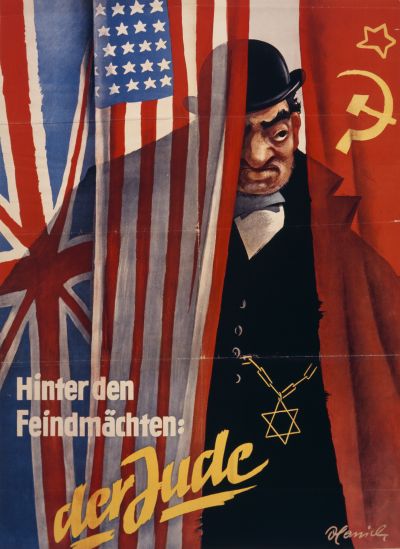 German propaganda poster on which the Jews are presented as sly manipulators of enemy powers. Source: U.S. Holocaust Memorial Museum.
German propaganda poster on which the Jews are presented as sly manipulators of enemy powers. Source: U.S. Holocaust Memorial Museum.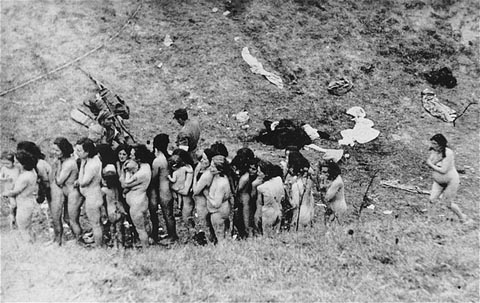 While it was officially forbidden, photos were regularly made of executions of Jews in the Soviet Union. This photo was made in Ukraine in 1942. The woman and children are set in a line while awaiting their execution by Ukrainian collaborators. Source: U.S. Holocaust Memorial Museum.
While it was officially forbidden, photos were regularly made of executions of Jews in the Soviet Union. This photo was made in Ukraine in 1942. The woman and children are set in a line while awaiting their execution by Ukrainian collaborators. Source: U.S. Holocaust Memorial Museum.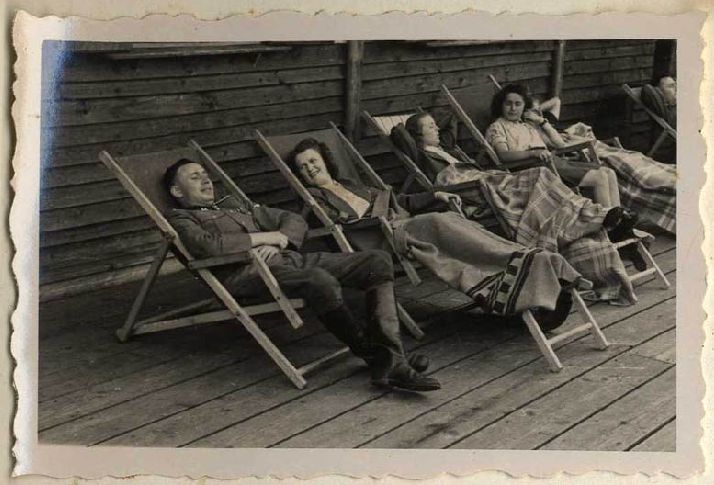 A SS man relaxes in the so called Solahütte, a recreation location for SS guards and their wives nearby Auschwitz. Source: U.S. Holocaust Memorial Museum.
A SS man relaxes in the so called Solahütte, a recreation location for SS guards and their wives nearby Auschwitz. Source: U.S. Holocaust Memorial Museum.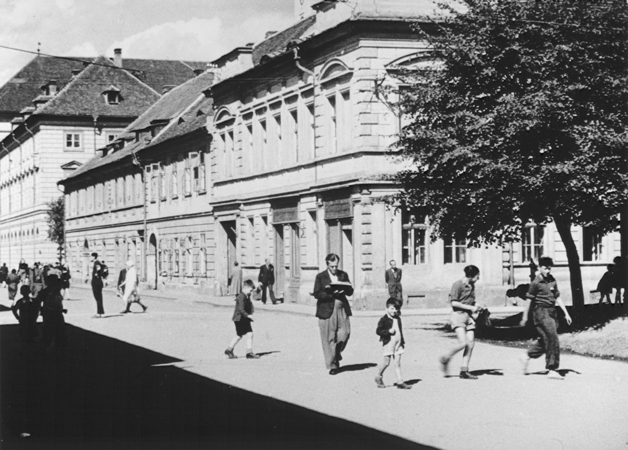 Screenshot from the propaganda movie The Führer gives the Jews a city. The life of the Jews in Theresienstadt looks very easy-going. Source: U.S. Holocaust Memorial Museum.
Screenshot from the propaganda movie The Führer gives the Jews a city. The life of the Jews in Theresienstadt looks very easy-going. Source: U.S. Holocaust Memorial Museum.Attitude of the German people
Revenge
The Germans were not particularly interested in the fate of the Jews during the last years of war. They had to survive in the cities which were bombed by the Allies, were worried about their husbands or sons fighting at the front or were mourning their own dead. The understanding, however, that the Jews had underwent something terrible, was widespread. Many saw the bombardments of the German cities and the defeat at the front as revenge for the suffering the Jews had undergone. A protestant priest from Württemberg wrote to the chancellor "that the suffering [the Germans] had endured by the hostile air attacks was revenge for what they had done to the Jews." Many Germans reacted negatively to the horror propaganda of Goebbels about the Red Army, as was reported by the Sicherheitsdienst on 6 November 1944. "Numerous people from all sections of the population" compared the cruelties of the Soviets with "the acts of terror we committed in hostile territory, even in Germany itself. Did we not murder thousands of Jews?"
Resistance
The church leaders and the resistance were better informed about the precise fate of the Jews than the ordinary Germans. However, protests of clergy or members of the resistance were weak or futile. In August 1943, the bishop from Berlin, Konrad von Preysing formulated a petition with the aim of having it signed by all German bishops and to then send it to Hitler and the other Nazi leaders. In it was written: "It is with great sorrow and even holy indignation that we, the German bishops, have taken note of a deportation of non-Aryan in a way that defies all human rights. […] The burden of our responsibility is becoming ever greater […] as we receive more and more shocking reports about the terrible, gruesome faith of the deported, who are subjected in great numbers to truly inhumane living circumstances." The plan to send the petition was rejected at the bishop conference. Von Preysing also did not have to count on the help of the Vatican. "Charity is all well and good, but the biggest deed of charity is avoiding problems for the church", according to the opinion of the papal nuncio in Berlin.
Significant is also the viewpoint of the resistance movement Freiburger Kreis. In the fall of 1942 they drew up a memorandum with ideas on Germany after the National Socialism. In it, they condemned the mass murder of Jews, however, at the same time they also argued that "the existence of a numeric population of Jews within a nation […] is a problem that will permanently lead to difficulties if no fundamental and large-scale arrangement are made for it." In the Germany after the National Socialism, no special measures against the Jews would be needed however "because the number of surviving Jews and the Jews who would return to Germany, would not be so large that it could be considered a threat to the German people." Anti-Semitism was therefore not only for fanatic Nazis, it was also deeply embedded in conservative and religious crowds. It is an important reason why so few Germans were concerned with the Jews; although many did not agree with the physical extermination, the viewpoint that Jews were a problem, was widely accepted.
German support for the Jews mainly came from individuals, such as the aforementioned Wilm Hosenfeld and the industrial Oskar Schindler, famous from the film "Schindler’s List" (1993).
Definitielijst
- Jews
- Middle Eastern people with own religion that lived in Palestine. They distinguished themselves by their strong monotheism and the strict observance of the Law and tradition. During World War 2 the Jewish people were ruthlessly persecuted and annihilated by the German Nazis. . An estimated 6,000,000 Jews were exterminated.
- National Socialism
- A political ideology drawn up by Hitler based on the superiority of the German race, the leader principle and fierce nationalism that was fed by the hard Peace of Versailles. National socialism was anti-democratic and racist. The doctrine was elaborated in Mein Kampf and organised in the NSDAP. From 1933 to 1945 National socialism was the basis of totalitarian Germany.
- Nazi
- Abbreviation of a national socialist.
- propaganda
- Often misleading information used to gain support among supporters or to gain support. Often used to accomplish ideas and political goals.
- Red Army
- Army of the Soviet Union.
- resistance
- Resistance against the enemy. Often also with armed resources.
- Socialism
- Political ideology aiming at slight or no class differences. Means of production are owned by the state. Evolved as a response to capitalism. Karl Marx tried to substantiate socialism scientific.
Images
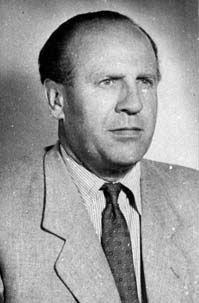 Oskar Schindler, the German industrial who rescued the life of more than 1.000 Jews. Source: Yad Vashem.
Oskar Schindler, the German industrial who rescued the life of more than 1.000 Jews. Source: Yad Vashem.After the war
Did not know
In the springtime of 1945, the people living in the neighbourhood of the concentration camps in Germany could behold the acts of terror performed by their fellow-countrymen with their own eyes. Forced by allied soldiers, they had to look at the piles of starved bodies and excavated mass graves. It was only the tip of the iceberg, but hardly any traces were visible from the mass murder in the east. The gas chambers in Auschwitz were blown up, the camps in Belzec, Sobibor and Treblinka were completely demolished and a special unit was concerned with removing the mass graves – all with the goal to erase the traces of genocide.
After the war, several high-placed Nazis claimed that not even they were aware of the extermination of the Jews. A well-known example is Albert Speer, who always claimed that he did not know about the Holocaust, despite the fact that he was an important confident of Hitler, contributed to the expansion of Auschwitz and most likely was present at a meeting in which Heinrich Himmler openly spoke about the extermination of the Jews. He was not convicted in Nuremberg for participation in the extermination programme and thus presumably avoided the death penalty.
Even the Nazis who were even more involved in the Holocaust claimed they did not know anything about it. For instance Albert Gemmeker, the camp commander of the transit camp Westerbork, from where 101,000 Jews were deported from the Netherlands to the east. Gemmeker claimed that although he had heard of the rumours of the extermination of the Jews, he believed his superiors, who had told him that he should not believe such "horror propaganda". His prosecutors did not succeed in proving that he knew of the mass destruction, causing him to only serve six years of the 10-year penalty he received. He would have probably gotten the death penalty if they could have proven he knew about it.
Concluding remarks
As was the case with Speer and Gemmeker, nowadays historics are of the opinion that they were aware of the extermination programme. However, a general conclusion on the position and viewpoints of the common German citizen, is much more difficult to make. It was possible to receive information on the extermination of Jews through various channels, but at the same time the government went to a lot of trouble to keep the extermination programme a secret, and during the years of war, most attention of the Germans first and foremost went out to their own suffering and fears. Most Germans will have known or at least suspected that things went badly for the Jews, but the full magnitude of the Holocaust was only known to party members, church leaders, people from the resistance movement and of course the offenders themselves.
The viewpoints of the German population with regard to what they did know about the Jew policy of the government also differed. A great support to exterminate the Jews was absolutely out of the question, because then it would not have been necessary for the Nazis to observe secrecy and to lie about the fate of the Jews. But this did not mean that the German population accepted the Jews as fully fledged Germans. Anti-Semitism was a completely normal thing and existed throughout all layers of the German population even before the war. Years of anti-Semitic propaganda by the Nazis did the rest. All this contributed to the protest against anti-Jewish measures being so weak, thus enabling the Holocaust. Practically nobody in Germany was truly interested in the fate of this unpopular minority. With regard to the passive attitude of the Germans, the well-known British historian Ian Kershaw concluded: "The road to Auschwitz was built by hate, but paved with indifference".
Definitielijst
- Holocaust
- Term for the destruction of European Jewry by the Nazis. Holokauston is the Greek term for a completely burnt sacrifice.
- Jews
- Middle Eastern people with own religion that lived in Palestine. They distinguished themselves by their strong monotheism and the strict observance of the Law and tradition. During World War 2 the Jewish people were ruthlessly persecuted and annihilated by the German Nazis. . An estimated 6,000,000 Jews were exterminated.
- propaganda
- Often misleading information used to gain support among supporters or to gain support. Often used to accomplish ideas and political goals.
- resistance
- Resistance against the enemy. Often also with armed resources.
Images
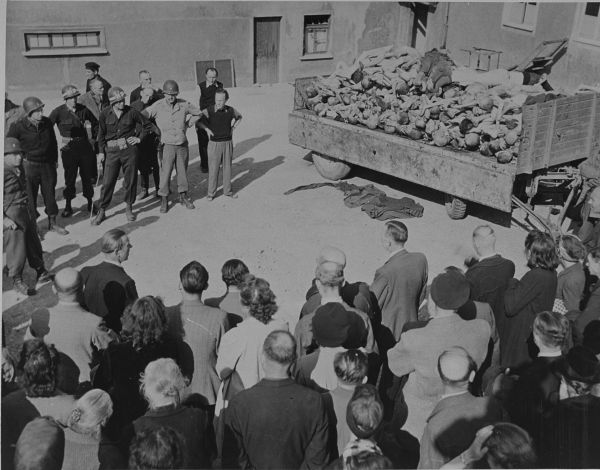 After the liberation of concentration camp Buchenwald in April 1945 German civilians are forced to watch the Nazi crimes with their own eyes. Source: U.S. Holocaust Memorial Museum.
After the liberation of concentration camp Buchenwald in April 1945 German civilians are forced to watch the Nazi crimes with their own eyes. Source: U.S. Holocaust Memorial Museum.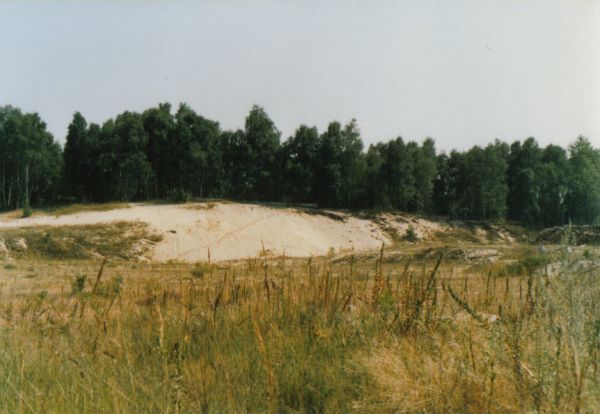 The extermination camps Belzec, Sobibor and Treblinka were completely dismantled by the Nazi’s to erase the traces of mass murder. On the photo the location of the former camp in Belzec. Source: Esther Dalberger.
The extermination camps Belzec, Sobibor and Treblinka were completely dismantled by the Nazi’s to erase the traces of mass murder. On the photo the location of the former camp in Belzec. Source: Esther Dalberger.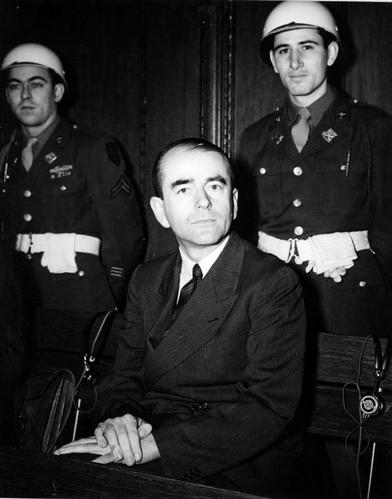 Nazi minister Albert Speer during the Nuremberg Trial. He is the personification of the "Wir haben es nicht gewusst"-myth. Source: Truman Library.
Nazi minister Albert Speer during the Nuremberg Trial. He is the personification of the "Wir haben es nicht gewusst"-myth. Source: Truman Library.Information
- Article by:
- Kevin Prenger
- Translated by:
- STIWOT translator
- Published on:
- 14-05-2015
- Last edit on:
- 02-05-2020
- Feedback?
- Send it!
Related sights
Related books
Sources
- FRIEDLäNDER, S., Nazi-Duitsland en de Joden, Nieuw Amsterdam, Amsterdam, 2007.
- JEFFREYS, D., Het kartel van de hel, De Bezige Bij, Amsterdam, 2009.
- KERSHAW, I., Hitler, de Duitsers en de Holocaust, Spectrum, Houten, 2009.
- KNOPP, G., Hitlers Holocaust, Byblos, Amsterdam, 2001.
- LUCKERT, S. & BACHRACH, S.D., State Of Deception, United States Holocaust Memorial Museum, Washington, 2009.
- SZPILMAN, W., De pianist, BZZTôH, 's Gravenhage, 2003.
